Animals
Discover the Enigmatic Realm of Invertebrates: A Comprehensive Overview of Insects, Arthropods, Mollusks, and Exoskeletons

Did you realize that invertebrates, an assorted group of animals without backbones, comprise over 95% of all known animal species on Earth? From the tiniest insects to the powerful arthropods and the elegant mollusks, these extraordinary creatures possess a wide array of adaptations and play crucial roles in ecosystems worldwide. Come along as we delve into the mysterious realm of invertebrates and delve into their remarkable diversity, captivating characteristics, and the intriguing world of exoskeletons.
Key Takeaways:
- Invertebrates make up over 95% of all known animal species on Earth.
- They include insects, arthropods, mollusks, and other fascinating creatures.
- Invertebrates have diverse characteristics, reproductive methods, and feeding strategies.
- They exhibit a wide range of adaptations to survive in various habitats.
- Invertebrates play critical roles in nutrient cycling, pollination, and biodiversity conservation.
What are Invertebrates and Their Diverse Characteristics?
In this section, we will delve into the definition of invertebrates and explore their diverse characteristics. We will discuss their absence of a backbone, soft bodies, body symmetry, segmented body, reproductive methods, nervous system, feeding and digestion mechanisms, respiratory systems, as well as their incredible diversity. By understanding the various traits and features of invertebrates, we can gain insights into their unique biology and adaptability.
Absence Of Backbone
Invertebrates are defined by their absence of a backbone or vertebral column. Unlike vertebrates, which have a bony structure that provides support and protection for their central nervous system, invertebrates rely on alternative mechanisms for structural support. This diverse group of animals includes insects, arthropods, mollusks, and many more, each with their unique adaptations to survive without a backbone.
Soft Bodies
Invertebrates are characterized by their soft bodies, which lack the rigid skeletal structures found in vertebrates. Instead of bones, they have flexible and often pliable bodies that allow them to maneuver through various habitats. The absence of bones gives invertebrates the ability to squeeze through small spaces and adopt different body shapes to suit their needs.
Body Symmetry
Invertebrates exhibit a wide range of body symmetry, including radial symmetry and bilateral symmetry. Radially symmetric invertebrates, such as jellyfish, have body parts arranged around a central axis, like the spokes of a wheel. Bilaterally symmetric invertebrates, on the other hand, have a distinct left and right side, often with specialized appendages or sensory organs that facilitate movement and feeding.
Segmented Body
Many invertebrates have segmented bodies, with repetitive sections or segments that house their various organ systems. This segmented arrangement allows for greater flexibility in movement and specialization of body regions. In some cases, segments can also be modified for specific functions, such as locomotion, sensory perception, or reproduction.
Reproduction And Development
Invertebrates have diverse methods of reproduction and development. Some species reproduce sexually, while others reproduce asexually through methods such as binary fission or budding. In terms of development, some invertebrates undergo metamorphosis, transforming from larvae to adults, while others exhibit direct development, where they resemble miniature versions of the adult form from birth.
Nervous System
Invertebrates possess a variety of nervous systems, ranging from simple nerve nets to more complex centralized nervous systems. These nervous systems allow them to perceive and respond to their environment, enabling behaviors such as movement, feeding, and reproduction. In some cases, invertebrates have specialized sensory structures, such as compound eyes in insects or tentacles in cnidarians.
Feeding And Digestion
Invertebrates exhibit a wide range of feeding strategies and digestive systems. Some are filter feeders, straining food particles from the water, while others are herbivores, carnivores, or scavengers. The diversity of invertebrate feeding methods is reflected in their varying digestive structures, including specialized jaws, grinding organs, or complex digestive chambers.
Respiratory Systems
Invertebrates have evolved diverse respiratory systems to obtain oxygen from their environment. Some absorb oxygen through their thin, moist skin, while others have specialized gills, tracheal tubes, or book lungs. These respiratory adaptations allow invertebrates to survive in a variety of habitats, from underwater environments to terrestrial ecosystems.
Diversity
Invertebrates encompass a tremendous diversity of species, making up the majority of animal life on Earth. They range from microscopic creatures to giants of the animal kingdom and inhabit virtually every habitat on the planet. From insects and arachnids to mollusks and crustaceans, invertebrates represent a remarkable array of life forms, each with its unique adaptations and ecological roles.
Ecological Importance
Invertebrates play critical roles in ecosystems and are essential for maintaining ecological balance. They contribute to nutrient cycling, pollination, seed dispersal, and decomposition. Invertebrates also serve as a food source for other organisms, acting as prey for birds, fish, and mammals. The ecological importance of invertebrates extends across various habitats, making them vital components of Earth’s biodiversity.
Types of Invertebrates: From Arthropods to Mollusks
In this section, we will explore the different types of invertebrates, with a focus on arthropods and mollusks. From segmented worms to jellyfish and from beetles to squids, the realm of invertebrates is incredibly diverse and captivating. Let’s dive into the fascinating world of these remarkable creatures and uncover their unique characteristics and adaptations.
Annelida: The Segmented Wrigglers
Annelids, commonly known as segmented worms, are a diverse group of invertebrates. Earthworms and leeches are well-known examples of annelids. With their segmented bodies, annelids play crucial roles in soil health, nutrient cycling, and serve as indicators of environmental conditions.
Nematoda: The Thread-like Survivors
Nematodes, or roundworms, are tiny thread-like worms found in various habitats. They possess incredible survival abilities and can thrive in soil, marine environments, and even as parasites in plants and animals. Nematodes play diverse roles in ecosystems, serving as decomposers, predators, and parasites.
Ctenophora: The Bioluminescent Drifters
Ctenophores, also known as comb jellies, are mesmerizing marine invertebrates. They are characterized by their bioluminescence and graceful swimming movements. Ctenophores occupy important roles in marine food webs as both predators and prey.
Porifera: The Simple Sponge Dwellers
Porifera, or sponges, are among the simplest multicellular animals. They primarily live in aquatic environments and play vital roles in marine ecosystems. Sponges filter-feed on microscopic organisms and serve as habitat structures for other organisms.
Cnidaria: The Stinging Ocean Dwellers
Cnidarians, including jellyfish, corals, and sea anemones, are incredibly diverse invertebrates found primarily in marine environments. They possess specialized stinging cells called cnidocytes, which they use for feeding and defense. Cnidarians are vital components of ocean ecosystems, contributing to coral reef formation and providing habitats for other species.
Mollusca (Mollusks): The Soft-bodied Shelled Creatures
Mollusks are a diverse group of invertebrates characterized by their soft bodies and often hard shells. This phylum includes fascinating creatures such as snails, clams, octopuses, and squids. Mollusks exhibit a wide range of adaptations and occupy various niches in both marine and terrestrial ecosystems.
Echinodermata (Echinoderms): The Spiny Marine Marvels
Echinoderms are marine invertebrates known for their spiny exoskeletons and unique water vascular systems. This phylum includes mesmerizing creatures such as sea stars, sea urchins, and sea cucumbers. Echinoderms play crucial roles in marine ecosystems, contributing to nutrient cycling and acting as keystone species in some habitats.
Platyhelminthes (Flatworms): The Sleek-bodied Creepers
Platyhelminthes, or flatworms, are a diverse group of invertebrates known for their flat, elongated bodies. This phylum includes a wide range of organisms, from free-living planarians to parasitic tapeworms. Flatworms occupy various habitats and exhibit remarkable adaptations for survival and reproduction.
Arthropoda (Arthropods): The Exoskeleton Clad Champions
The arthropod phylum comprises the largest and most diverse group of invertebrates. Arthropods are characterized by their jointed appendages and exoskeletons made of chitin. From insects and spiders to crustaceans, arthropods have conquered nearly every habitat on Earth, playing essential roles as pollinators, decomposers, predators, and more.
Insects: The Multitude of Tiny Wonders
Insects, a class within the arthropod phylum, are the most diverse group of organisms on Earth. They showcase an astounding range of adaptations, life cycles, and ecological roles. Insects play vital roles as pollinators, decomposers, predators, and prey, contributing to the maintenance of healthy ecosystems.
Arachnids (Arachnida): The Eight-legged Predators
Arachnids are another class within the arthropod phylum, known for their intriguing eight legs. Spiders, scorpions, and ticks are among the fascinating creatures in this group. Arachnids occupy diverse habitats and play important roles as both predators and prey in ecosystems.
Crustaceans (Crustacea): The Shelled Sea Creatures
Crustaceans, such as crabs, lobsters, and shrimp, are a diverse group of arthropods primarily found in aquatic environments. They exhibit a wide range of body forms and occupy various ecological roles. Crustaceans play essential roles in nutrient recycling and serve as a valuable food source for humans and other animals.
Unraveling the World of Arthropods: Beetles, Spiders, and Crustaceans
Arthropods, including beetles, spiders, and crustaceans, encompass incredible diversity and fascinating traits. Beetles, with their hard exoskeletons and an unparalleled abundance of species, are the most numerous insects on Earth. Spiders, known for their intricate webs and venomous fangs, demonstrate exceptional predatory skills. Crustaceans, such as crabs and lobsters, possess adaptable bodies and unique locomotion mechanisms that allow them to thrive in various marine environments.
Diving Deeper into the Mollusk Family: Snails, Squids, and Clams
Mollusks encompass a wide range of captivating creatures, including snails, squids, and clams. Snails have spiral shells and inhabit diverse terrestrial and aquatic environments. Squids showcase complex behaviors and remarkable anatomical features, making them agile marine predators. Clams, with their bivalve shells, are filter-feeding organisms found in both freshwater and marine habitats.
Examining the Fascinating Diversity of Jellyfish and Other Cnidarians
Cnidarians, which include jellyfish, corals, and sea anemones, captivate with their unique physical and behavioral adaptations. Jellyfish, with their graceful tentacles and stinging cells, enchant with their otherworldly appearance. Corals form intricate structures through symbiotic relationships with photosynthetic algae, contributing to the creation of coral reefs. Sea anemones, with their delicate bodies and venomous tentacles, exemplify the diversity of cnidarians.
Evolution and Adaptations of Invertebrates
Invertebrates have undergone remarkable evolution and developed unique adaptations that have allowed them to thrive in diverse environments. From the role of exoskeletons in arthropods to the fascinating features of marine invertebrates like feather stars and sponges, and the adaptations of insects and mollusks in various habitats, invertebrates have demonstrated incredible resilience and survival strategies.
The Role of Exoskeletons in Arthropods and Their Survival Advantages
Arthropods, including insects, spiders, and crustaceans, possess exoskeletons made of chitin. These external skeletons provide arthropods with essential support, protection, and structural integrity. Exoskeletons offer significant advantages, such as resistance to desiccation, physical injuries, and predation. Their rigid nature allows for efficient movement and acts as a barrier against external threats.
Exoskeletons also provide arthropods with a platform for muscle attachment, enabling powerful movements and actions. As arthropods grow, they molt their old exoskeletons and produce new ones, allowing for continuous growth and development. This adaptive feature has contributed to the evolutionary success of arthropods, allowing them to colonize various habitats and niches.
Exploring the Unique Features of Marine Invertebrates like Feather Stars and Sponges
Marine invertebrates display fascinating adaptations that enable them to thrive in the challenging environment of the ocean. Feather stars, for example, are free-swimming and filter-feeding creatures. They have a unique feeding mechanism that involves capturing food particles using their feather-like arms. This adaptation allows them to efficiently obtain nutrients from the water column.
Sponges, on the other hand, are sessile organisms that form intricate structures with specialized cells. They are filter feeders, extracting nutrients from the water that passes through their porous bodies. Sponges possess a remarkable regenerative ability, and even small fragments can grow into fully functional individuals. Their adaptive features contribute to their survival in marine ecosystems and their ability to maintain structural integrity despite constant water movement.
Adaptations of Insects and Mollusks in Various Habitats and Environments
Insects have evolved a wide array of adaptations that allow them to thrive in diverse habitats and environments. Some insects, like butterflies, have developed wings for flight, enabling them to explore vast territories and access new food sources and reproductive opportunities. Others have evolved camouflage mechanisms to blend in with their surroundings, enhancing their ability to evade predators and capture prey.
Mollusks, such as snails, squids, and clams, have also developed unique adaptations to suit their respective habitats. Snails have evolved shells to provide protection and create a moisture-rich environment. Squids, with their streamlined bodies and powerful jet propulsion, are well-adapted for agile movement in the open ocean environment. Clams possess strong shells that allow them to burrow into sediment or attach to rocky substrates, ensuring their survival in diverse aquatic environments.
By examining the evolution and adaptations of invertebrates, we gain a deeper understanding of their remarkable ability to adapt to various ecological niches. These adaptations have contributed to the resilience and success of invertebrates in the face of environmental challenges, making them one of the most diverse and fascinating groups of organisms on the planet.
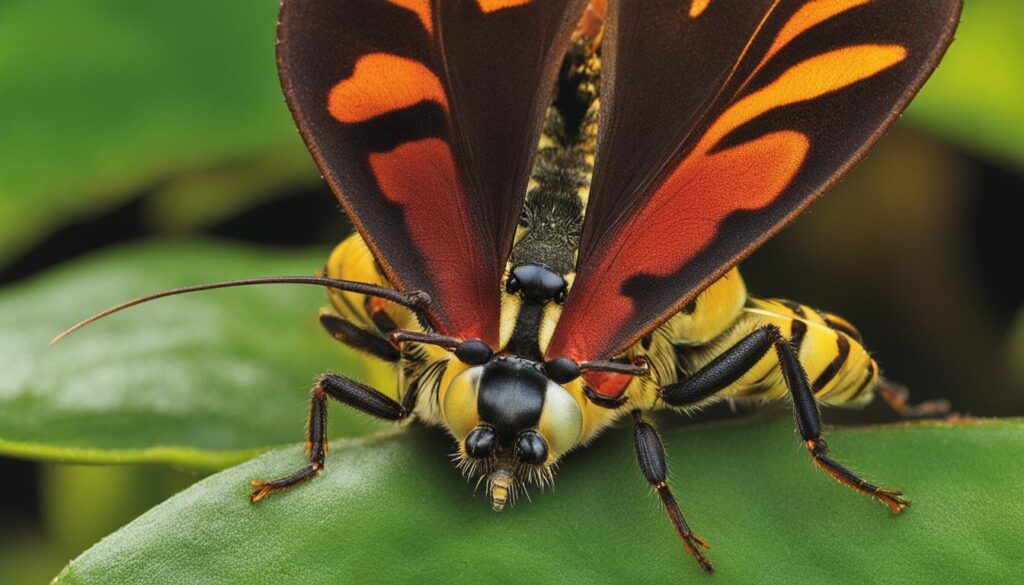
Threats, Conservation, and the Future of Invertebrate Species
Invertebrate species face numerous threats that endanger their survival and contribute to biodiversity loss. The impact of climate change and human activities poses significant challenges for these vulnerable creatures. However, conservation efforts and the recognition of the importance of invertebrates can help secure their future.
Understanding the Impact of Climate Change and Human Activities on Invertebrate Populations
Climate change has far-reaching consequences for invertebrate populations. Rising temperatures, altered precipitation patterns, and extreme weather events disrupt their habitats and life cycles. Invertebrates rely on specific environmental conditions and have evolved to thrive in their natural habitats. As these conditions change, invertebrates struggle to adapt, leading to declining populations and potential extinctions.
Human activities further exacerbate the threats faced by invertebrates. Habitat destruction, pollution, and the introduction of invasive species contribute to the decline in invertebrate populations. Uncontrolled urbanization, deforestation, and intensive agriculture lead to the loss and fragmentation of their habitats. Pollution, including chemical pollutants and plastic waste, contaminates their environments. The introduction of invasive species disrupts the delicate balance of ecosystems, outcompeting and preying on native invertebrates.
Conservation Efforts for Vulnerable Invertebrate Species: Challenges and Solutions
Conserving vulnerable invertebrate species presents several challenges. Limited knowledge about their distributions and life cycles, as well as insufficient funding, hinders conservation efforts. Additionally, the small size and inconspicuous nature of many invertebrates make them difficult to study and protect effectively.
However, solutions exist to address these challenges. The establishment of protected areas and conservation reserves plays a crucial role in safeguarding invertebrate habitats. These areas provide undisturbed ecosystems where invertebrate populations can thrive. Habitat restoration projects, such as reforestation and wetland regeneration, are vital in creating suitable habitats for invertebrates.
Captive breeding programs offer a solution for the conservation of rare and endangered invertebrate species. By breeding and reintroducing these individuals into the wild, conservationists increase their chances of survival and population recovery. Public awareness initiatives, education, and engagement foster a deeper understanding and appreciation for invertebrates, leading to increased support for conservation efforts.
Discussing the Importance of Invertebrates in Habitat Restoration and Biodiversity Conservation
Invertebrates play a crucial role in habitat restoration and biodiversity conservation. Their interactions with plants, including pollination and seed dispersal, contribute to the reproduction and survival of many species. Invertebrates also play key roles in nutrient cycling, breaking down organic matter and facilitating the release of nutrients back into the ecosystem. Without invertebrates, essential ecological processes would be disrupted, endangering the stability and health of ecosystems.
Promoting the conservation of invertebrates is necessary to preserve biodiversity. Invertebrates constitute a substantial portion of the global species richness, and their protection ensures the integrity of ecosystems. By conserving invertebrates, we maintain the balance of natural communities and secure the future of countless plant and animal species.
Threats And Conservation Of Invertebrates:
Invertebrates face numerous threats that jeopardize their survival and well-being. Understanding these threats and implementing effective conservation strategies is crucial for the protection of these remarkable creatures.
Habitat loss and fragmentation
Habitat loss and fragmentation are significant threats to invertebrates. Human activities such as deforestation, urbanization, and agriculture destroy or fragment natural habitats, disrupting the ecological balance and threatening the survival of invertebrate populations. As their habitats diminish, invertebrates face challenges in finding food, shelter, and suitable breeding grounds. Conservation efforts must prioritize habitat conservation and restoration to ensure the long-term survival of these species.
Climate change
Climate change poses a major challenge to the survival of invertebrate species. Rising temperatures, shifts in precipitation patterns, and extreme weather events can disrupt their reproductive cycles, alter habitats, and reduce food availability. Invertebrates, with their specialized adaptations to specific environments, may struggle to cope with the rapid changes brought on by climate change. Mitigation and adaptation strategies, such as conserving diverse habitats and creating climate-resilient landscapes, are needed to safeguard invertebrate populations.
Pollution
Pollution, including chemical contaminants, plastic debris, and nutrient runoff, poses significant risks to invertebrate species and their habitats. Invertebrates are highly sensitive to pollution and can suffer adverse effects on their physiology, behavior, and reproductive capabilities. To protect invertebrates from pollution, it is essential to reduce and manage sources of pollution, promote sustainable waste management practices, and advocate for cleaner technologies.
Invasive species
Invasive species pose a serious threat to invertebrates by outcompeting native species and disrupting the delicate balance of ecosystems. Invasive species can displace native invertebrates from their habitats, alter their food sources, and introduce new diseases and parasites. Preventing the introduction and spread of invasive species is crucial for safeguarding invertebrate populations. This can be achieved through comprehensive monitoring, early detection, and effective management strategies.
Overexploitation
Overexploitation, including unsustainable harvesting and collection practices, can deplete invertebrate populations and degrade their habitats. Invertebrates, such as certain species of mollusks, crustaceans, and insects, are often exploited for various purposes, including food, medicine, and the pet trade. Sustainable management practices, such as regulating fishing and hunting practices, implementing harvest quotas, and promoting responsible consumer choices, are necessary to ensure the long-term survival of these species.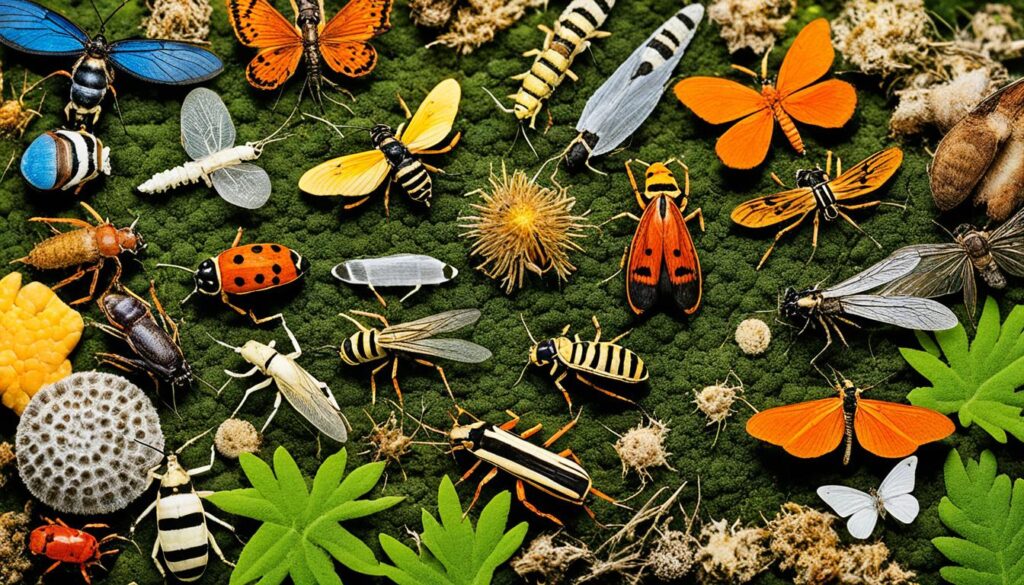
Conclusion
In conclusion, the realm of invertebrates is a fascinating and diverse world filled with incredible creatures. From insects and arthropods to mollusks and other invertebrate groups, they occupy vital ecological roles and contribute to the overall health and balance of ecosystems.
However, invertebrates face numerous threats, including habitat loss, climate change, pollution, invasive species, and overexploitation. These challenges endanger their populations and jeopardize their ecological importance.
To ensure the future survival and conservation of invertebrates, it is crucial to understand their significance and implement effective conservation efforts. This can be achieved through education, awareness, and collective action.
By fostering a greater appreciation for the enigmatic realm of invertebrates, we can inspire individuals and communities to take part in protecting and preserving these remarkable creatures. Together, we can make a difference in safeguarding the diversity and ecological importance of invertebrates, ensuring a thriving and balanced planet for generations to come.FAQ
What are invertebrates?
What are some characteristics of invertebrates?
Why are invertebrates important?
What are some examples of invertebrates?
How do invertebrates reproduce and develop?
What are some threats to invertebrate species?
How can we conserve vulnerable invertebrate species?
As our Editor-in-Chief, James plays a pivotal role in ensuring the quality and integrity of our content. With a keen eye for detail and a passion for storytelling, James oversees the editorial process here at A Place for Animals. With years of experience in content editing, James ensures that every piece of content meets our high standards of accuracy and clarity. Under James’ guidance, you can rest assured that the content you read is informative and impeccably crafted.
Animals
Discover Animals That Start with Z: An A-Z Guide
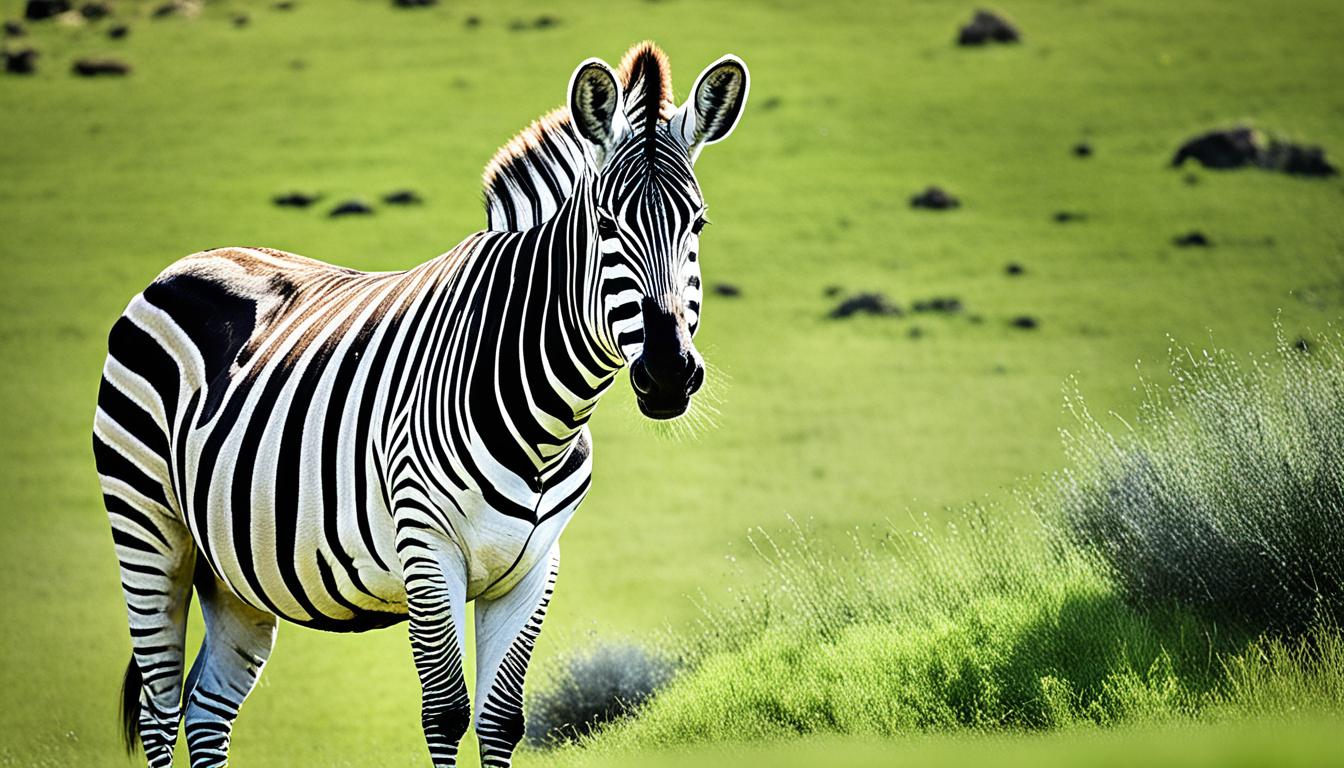
Are you aware that there are many captivating animals whose names start with the letter Z? This A-Z guide is here to introduce you to the exciting world of animals that begin with Z. Prepare to learn some unexpected information and encounter creatures that may be new to you! Join the adventure and delve into the fascinating realm of these unique animals.
Key Takeaways:
- Animals that start with Z offer a wide range of species with different characteristics and habitats.
- Zebras are iconic African animals known for their distinctive black and white stripes.
- Zebra finches are common grassfinches found in Australia’s drier regions.
- Zebrafish are striped freshwater fish native to India and South Asia.
- Zebra sharks have unique appearances with spots as adults and stripes as juveniles.
- Zebu is a subspecies of domestic cattle known for their hump above their shoulder.
- Zorilla, also known as the striped polecat, is a member of the weasel family found in Southern Africa.
Zebras: The Iconic Animal That Starts with Z
Zebras, majestic animals that start with the letter Z, are widely recognized for their striking appearance and have become an emblem of the African wilderness. These remarkable creatures inhabit the vast treeless grasslands and savannah woodlands of southern and eastern Africa.
The most distinguishing feature of zebras is their distinctive black and white stripes, which vary in patterns across different species. These patterns act as a form of camouflage, making it difficult for predators to single out an individual zebra from a herd. Additionally, each zebra’s stripe pattern is unique, similar to the human fingerprint, allowing researchers to identify and study them in the wild.
Zebras are known for their social nature and commonly gather in large herds, providing protection against predators. Being herbivores, they primarily graze on grasses, leaves, and bark. Their strong jaws and sharp incisor teeth enable them to feed on tough vegetation, while their mobile lips have evolved to grasp and strip leaves from branches.
Considered close relatives of horses and donkeys, zebras exhibit similar behaviors, such as neighing, braying, and snorting. However, unlike their domestic counterparts, zebras retain their wild instincts and can be challenging to tame or domesticate.
The Role of Zebras in Ecosystems
Zebras play a vital role in the African ecosystems they inhabit. They have a symbiotic relationship with other grazers, especially wildebeests and antelopes, collectively referred to as “megaherbivores”. This relationship ensures the ecological balance and promotes plant diversity in the grasslands.
“Zebras have a profound impact on the ecosystems they inhabit. Through their grazing activities, they help control vegetation growth, preventing grasslands from becoming overgrown and providing a suitable habitat for other wildlife species.”
The Conservation Status of Zebras
Despite their widespread distribution, zebras face several conservation challenges due to habitat loss, competition with livestock for resources, and illegal hunting. Efforts are underway in various African countries to protect and conserve these iconic animals and their habitats.
Zebra Finches: Common Grassfinches from Australia
Zebra finches, also known as Taeniopygia guttata, are one of Australia’s most common grassfinches. They are native to the continent and can be found in the drier regions of Australia. These charming birds are beloved for their beautiful plumage and delightful songs.
Zebra finches are small-sized birds, typically measuring around 4 to 5 inches in length. They have a rounded body shape and a distinctive beak. What sets them apart is their striking markings. Zebra finches feature a striped tail and stripes around their eyes, resembling the patterns seen on zebras, hence their name.
These sociable birds are highly gregarious and typically live in flocks, especially during the breeding season. They build their nests in bushes and trees, constructing intricate structures using grass, feathers, and other natural materials.
Zebra finches are not only popular for their beauty but also for their captivating behaviors. Male zebra finches are known for their elaborate courtship displays, where they sing and dance to attract females. Their melodious songs fill the air and are often used to communicate and establish territories.
These birds have a diverse diet, consisting of seeds, grains, fruits, and insects. Their adaptability and resilience have allowed them to thrive in various environments, including urban areas, making them a common sight in many Australian gardens and aviaries.
Here is a quote from renowned ornithologist John James Audubon:
“Zebra finches are remarkable little birds with their melodious voices and striking markings. They bring joy to avian enthusiasts and add a touch of vibrancy to the Australian landscape.”
The Adaptability of Zebra Finches
Zebra finches possess remarkable adaptability, enabling them to survive and thrive in diverse environments. Their ability to breed easily in captivity has made them popular pets and subjects for scientific research. Researchers have studied zebra finches to understand various aspects of avian behavior, including courtship rituals, vocal learning, and neurobiology.
Their adaptability extends beyond their physical surroundings. Zebra finches are known for their ability to adjust their songs based on their social environment. They can learn and imitate songs from other individuals, creating a unique vocal repertoire within their flock.
Zebra finches are highly social birds and form strong pair bonds. They often mate for life, displaying cooperative behaviors in raising their young. These sociable birds communicate through vocalizations, including various calls and songs.
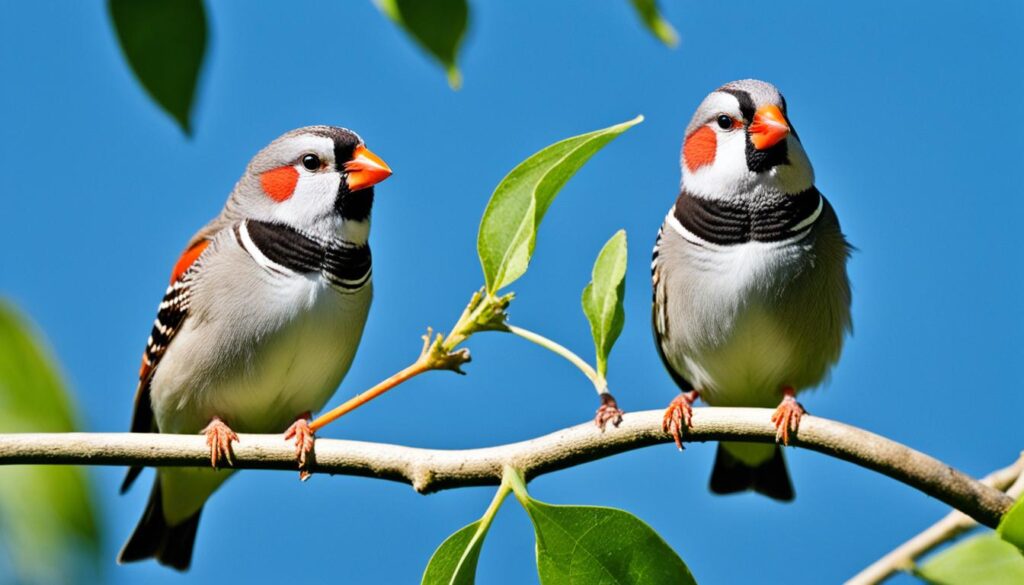
| Zebra Finches | Zebra Sharks | Zebra Pleco |
|---|---|---|
| Size: 4-5 inches | Size: Up to 10 feet | Size: Up to 4 inches |
| Habitat: Drier regions of Australia | Habitat: Tropical Indo-Pacific Ocean | Habitat: Xingu River in Brazil |
| Distinctive Feature: Striped tail and markings around the eyes | Distinctive Feature: Black spots as adults, stripes as juveniles | Distinctive Feature: Black and white stripes |
| Characteristics: Sociable, melodious singers | Characteristics: Bottom-dwelling, gentle sharks | Characteristics: Popular aquarium fish |
Zebra finches add to the rich biodiversity of Australian birdlife and have become synonymous with the country’s natural beauty. Their endearing presence and captivating songs make them a favorite amongst birdwatchers and avian enthusiasts worldwide.
Zebrafish: A Striped Freshwater Fish
The zebrafish is a fascinating aquatic creature that captivates both fish enthusiasts and scientists alike. Native to India and South Asia, zebrafish (Danio rerio) have gained popularity as aquarium fish due to their vibrant colors and unique patterns. They belong to the minnow family, Cyprinidae, and are known for their distinctive stripes, which run horizontally along their slender bodies.
While zebrafish may seem like any other aquarium fish, they have become an essential component of medical research, particularly in the field of regenerative medicine. Zebrafish possess remarkable regenerative abilities, capable of regrowing damaged fins, hearts, and even parts of their spinal cord. These remarkable characteristics make zebrafish a highly valuable model organism for studying human health and development.
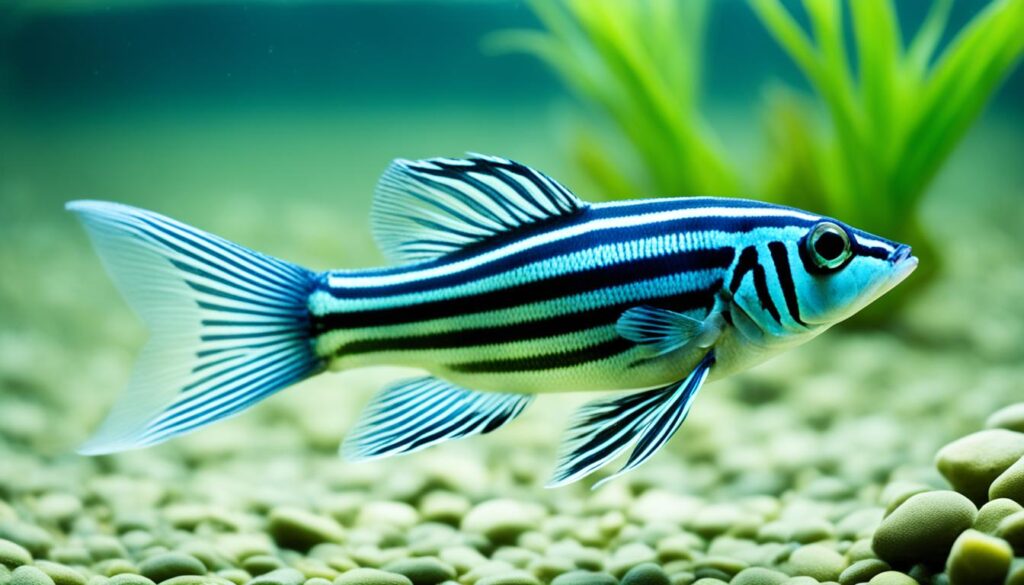
Scientists utilize zebrafish in a wide range of research studies, from investigating genetic mutations to understanding the development of various organs and tissues. Due to their genetic similarities to humans, zebrafish provide valuable insights into the underlying mechanisms of diseases and potential therapeutic interventions.
Moreover, zebrafish have a relatively short reproductive cycle, with females producing hundreds of eggs each week. This rapid reproduction allows researchers to study multiple generations of zebrafish in a short period, accelerating the pace of scientific discoveries.
In summary, zebrafish are not just visually stunning creatures to admire in aquariums; they also serve as vital contributors to scientific advancements and breakthroughs in various fields. Their regenerative abilities and genetic similarities to humans have cemented their position as an invaluable resource for medical research.
Zebra Sharks: Spotted Beauties of the Ocean
When it comes to fascinating marine creatures, zebra sharks are truly a sight to behold. Also known as leopard sharks, these magnificent creatures have a unique appearance that sets them apart from other animals that start with Z.

One of the most striking features of zebra sharks is their distinct pattern. Interestingly, these sharks have spots as adults and stripes as juveniles, making them quite the chameleon of the sea. Their bodies are adorned with beautiful markings that resemble the patterns of zebras, hence their name.
Found in the tropical Indo-Pacific Ocean, zebra sharks gracefully navigate the coral reefs and sandy bottoms. They are typically spotted in the waters of the Red Sea, the Maldives, and Australia. These sharks are known for their gentle nature, making them a favorite among divers and snorkelers.
Zebra sharks have a relatively long lifespan, with some individuals living up to 30 years. They can grow up to 8 feet in length, making them impressive creatures of the deep. While they are primarily bottom-dwellers, zebra sharks are proficient swimmers and can cover substantial distances in search of food.
“Zebra sharks are fascinating creatures with their distinct markings and graceful presence in the ocean,” says marine biologist Dr. Sarah Johnson. “Their ability to change coloration as they mature is truly remarkable.”
Fun Fact: Did you know that zebra sharks are often mistaken for nurse sharks? While they do share some similarities, such as their docile nature and similar body shape, zebra sharks can be easily distinguished by their unique markings.
| Zebra Sharks | Features |
|---|---|
| Scientific Name | Stegostoma fasciatum |
| Habitat | Tropical Indo-Pacific Ocean |
| Length | Up to 8 feet |
| Coloration | Spots as adults, stripes as juveniles |
| Lifespan | Up to 30 years |
The table above provides a summary of key features of zebra sharks, highlighting their scientific name, habitat, length, coloration, and lifespan.
Zebra sharks play an important role in maintaining the delicate balance of their underwater ecosystems. As they feed on small fish, crabs, and other invertebrates, they help regulate population sizes and keep the food chain in check.
Whether you’re an avid lover of marine life or simply intrigued by extraordinary creatures, zebra sharks are undoubtedly a captivating species to learn about and admire.
Zebu: Domestic Cattle with a Hump
Zebu is a subspecies of domestic cattle known for their hump above their shoulder and loose skin. They are usually red or grey in color and have horns and large ears.
These unique characteristics set zebu apart from other cattle breeds. The hump, composed primarily of fat, helps zebu endure harsh environments and limited food resources. Additionally, their loose skin acts as a cooling mechanism, allowing them to survive in hot climates.
Zebu cattle have been domesticated for centuries and are valued for their adaptability, resilience, and milk production. They are commonly found in tropical regions, particularly in Asia, Africa, and parts of South America.
Due to their remarkable ability to withstand extreme temperatures and drought conditions, zebu cattle play a vital role in the agricultural practices of many communities around the world. They are used for their milk, meat, and as draft animals in plowing fields.
Key Features of Zebu:
- Distinctive hump above their shoulder
- Loose skin for heat dissipation
- Usually red or grey in color
- Horns and large ears
- Adaptability to harsh environments
Despite their unique attributes, zebu cattle share many similarities with other bovine species. They are herbivores, primarily feeding on grass and other vegetation, and have a social structure that revolves around herds led by dominant individuals.
Zebu cattle have been an integral part of various cultures, providing sustenance, transportation, and materials for clothing and shelter. Their humped appearance and resilience have made them an iconic symbol of agricultural traditions in different parts of the world.
Zorilla: The Striped Polecat
The zorilla, also known as the striped polecat, is a fascinating member of the weasel family. Found in Southern Africa, these small carnivores are known for their distinctive appearance and unique behavior. Zorillas have a slender body with black fur, crossed by prominent white stripes. This coloration acts as a warning signal to potential predators, indicating that they possess a potent defense mechanism.
“The zorilla is a remarkable creature with a powerful defense mechanism. When threatened, it can release a noxious spray, similar to that of a skunk. This pungent odor serves as a warning to predators, deterring them from pursuing an attack.”
Zorillas primarily inhabit grasslands, woodlands, and savannahs, where they can find an abundance of their favored prey. Their diet consists of various small animals, including rodents, snakes, birds, and insects. With their sharp teeth and strong jaws, zorillas are skilled hunters capable of capturing agile prey.
Let’s take a closer look at the key characteristics of zorillas:
Key Characteristics of Zorillas
- Appearance: Zorillas have a slender body covered in black fur with prominent white stripes. They have short legs, a bushy tail, and a pointed snout.
- Size: Adult zorillas typically measure around 30-40 cm in length, excluding their tail, which adds an additional 20-25 cm.
- Habitat: They are found in various habitats within Southern Africa, including grasslands, woodlands, and savannahs.
- Noxious Spray: Zorillas possess specialized scent glands that can release a pungent spray when threatened.
- Behavior: Zorillas are primarily nocturnal animals, preferring to hunt and forage during the cover of darkness.
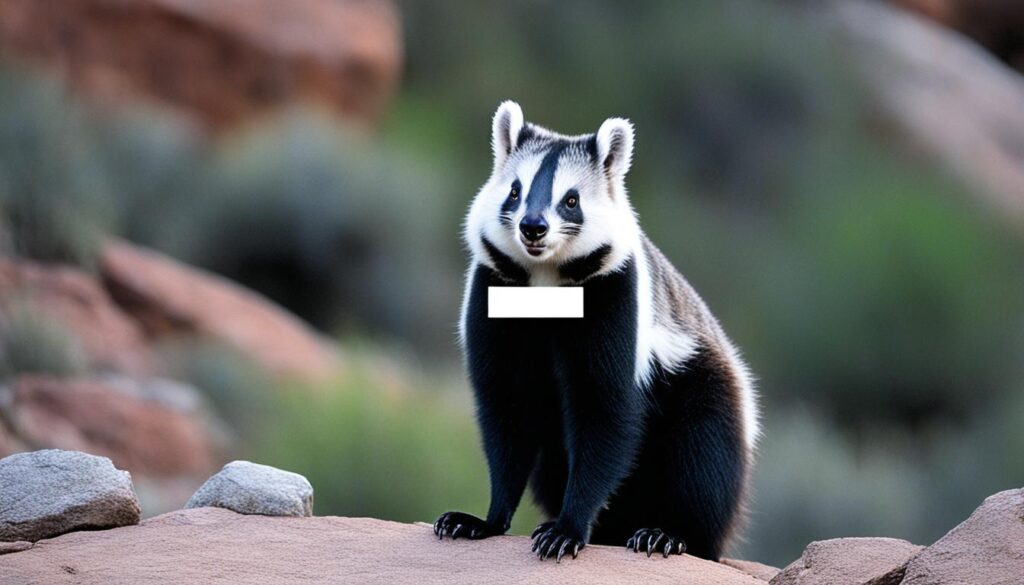
In addition to their unique appearance and defensive abilities, zorillas play a vital role in their ecosystem. As efficient hunters, they help control populations of rodents and other small animals. Their presence contributes to the overall balance and biodiversity of Southern African habitats.
Next, we will explore other fascinating animals that start with the letter Z, including the zebra duiker, zebra seahorse, zebra pleco, zebra mussel, and zigzag eel.
Other Animals That Start with Z
Aside from the iconic zebras, zebra finches, zebrafish, zebra sharks, zebu, and zorilla, there are several other fascinating animals that bear the letter Z in their names. Let’s explore some of them:
Zebra Duiker
The Zebra duiker is a unique antelope found in the West African rainforest. It sports a distinctive coat with black stripes on a background of brown and tan. These secretive animals are known for their nocturnal behavior and are highly adapted to life in dense vegetation. The Zebra duiker primarily feeds on leaves, fruits, and seeds, making them important contributors to seed dispersal in their ecosystem.
Zebra Seahorse
The Zebra seahorse is a captivating marine species known for its striped appearance. These small seahorses can be found near coral reefs in northern Australia. The males take on the unique reproductive role of carrying and nurturing the developing embryos in their abdominal pouches. Zebra seahorses are excellent swimmers, using their prehensile tails to anchor onto coral reefs and other surfaces.
Zebra Pleco
The Zebra pleco is a strikingly beautiful freshwater fish native to the Xingu River in Brazil. It is highly sought after by aquarium enthusiasts due to its distinctive black and white stripes and docile nature. These nocturnal fish prefer hiding in rocks and crevices during the day and emerge to feed on small invertebrates at night.
Zebra Mussel
The Zebra mussel is a small freshwater mussel that has become an invasive species in many parts of the world. Originating from Eastern Europe, they have spread to various water bodies across North America, Europe, and Asia. Zebra mussels attach themselves to hard surfaces using sticky threads called byssal threads. Their rapid reproduction and ability to outcompete native species have led to significant environmental and economic impacts.
Zigzag Eel
The Zigzag eel, also known as the leopard spiny eel, is a fascinating freshwater fish popular in the aquarium trade. It displays an eye-catching pattern of dark zigzag stripes on a lighter background. These eels are nocturnal and dwell at the bottom of rivers and streams, favoring areas with dense vegetation. They are carnivorous, feeding on small invertebrates and occasionally small fish.
| Animal | Description |
|---|---|
| Zebra Duiker | An antelope with black stripes on a brown and tan coat. Found in the West African rainforest. |
| Zebra Seahorse | A marine species characterized by black and white stripes. Found near coral reefs in northern Australia. |
| Zebra Pleco | A freshwater fish with distinctive black and white stripes. Native to the Xingu River in Brazil. |
| Zebra Mussel | A small invasive freshwater mussel with black and white striped shells. Has spread to various water bodies worldwide. |
| Zigzag Eel | A freshwater eel with dark zigzag stripes on a lighter body color. Popular in the aquarium trade. |
Zebra Duiker: A Unique Antelope from Africa
The Zebra Duiker is a fascinating antelope species native to the West African rainforest. These small-sized antelopes are renowned for their distinctive brown and tan coat adorned with black stripes, which give them their name. The zebra-like pattern provides excellent camouflage amidst the dense foliage of their forest habitat.
Zebra duikers possess elongated snouts equipped with prehensile lips, allowing them to easily feed on leaves, fruits, and fallen flowers. Their diet primarily consists of vegetation, providing them with the necessary nutrients to thrive in their environment.
One of the remarkable aspects of zebra duikers is their nocturnal behavior. They are predominantly active during the night, utilizing their well-developed sense of smell and impressive agility to navigate through the underbrush under the cover of darkness.
Although elusive and largely solitary, zebra duikers occasionally form small family groups, consisting of a male, female, and their offspring. These family units help promote social bonds and provide protection against potential predators.
The zebra duiker is listed as a vulnerable species due to habitat loss caused by deforestation and hunting for bushmeat. Conservation efforts are crucial to protect these magnificent creatures and preserve the biodiversity of the West African rainforest.
“The zebra duiker’s unique striped coat and adaptability to the rainforest make it a fascinating animal to study and admire. Its conservation is vital to maintain the delicate balance of nature in its native habitat.” – Wildlife Conservationist
Characteristics of the Zebra Duiker
| Characteristics | Description |
|---|---|
| Habitat | West African rainforest |
| Coat Color | Brown and tan with black stripes |
| Diet | Leaves, fruits, fallen flowers |
| Activity | Nocturnal |
| Group Structure | Occasional small family groups |
| Conservation Status | Vulnerable |

Zebra Seahorse: Stripes in the Ocean
Zebra seahorses are fascinating creatures known for their striking black and white stripes. Found near coral reefs in northern Australia, these seahorses are a captivating sight in the underwater world.
One remarkable feature of zebra seahorses is their unique reproductive behavior. Unlike most other animals, it is the male seahorse who carries the developing embryos in a specialized pouch. This makes them one of the few species in the animal kingdom where males become pregnant.
These mesmerizing seahorses rely on camouflage provided by their bold stripes, enabling them to blend perfectly into their surroundings. This helps them hide from predators and hunt their prey, mainly small crustaceans and tiny fish.
Zebra seahorses have a slender body and a long snout, which they use to suck up their food. They also have a small dorsal fin that helps them maintain balance while swimming in the ocean currents.
“The zebra seahorse is a true marvel of nature. Their intricate striped patterns and unique reproductive behavior make them a fascinating species to study and appreciate.” – Marine biologist Dr. Sarah Johnson
Due to various environmental factors, including habitat loss and pollution, zebra seahorses are facing threats to their population numbers. Conservation efforts are crucial to ensure the survival of these remarkable creatures and protect their delicate ecosystems.
Zebra Seahorse Quick Facts
| Scientific Name | Hippocampus zebra |
|---|---|
| Family | Syngnathidae |
| Habitat | Found near coral reefs in northern Australia |
| Size | Approximately 10 centimeters |
| Diet | Small crustaceans and tiny fish |
| Reproduction | Males become pregnant and carry developing embryos in a pouch |
These unique seahorses serve as a reminder of the remarkable diversity found in our oceans. Their distinct stripes and intriguing behavior make them a captivating addition to the animal kingdom.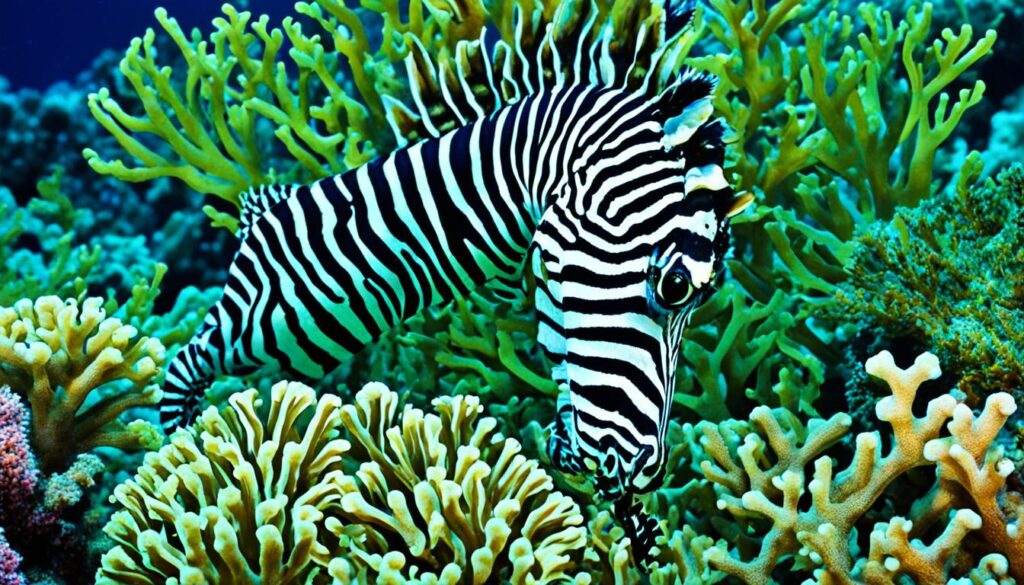
Zebra Pleco: A Striped Fish for Aquariums
Zebra plecos are a sought-after species among aquarium enthusiasts, known for their striking black and white stripes. These captivating fish are native to the Xingu River in Brazil, which adds to their allure and exclusivity.
One of the most fascinating features of zebra plecos is their unique appearance. Their bold, contrasting stripes make them stand out in any aquarium, creating an eye-catching focal point. With their sleek body and intricate patterning, they bring a touch of elegance to aquatic environments.
Unlike other pleco species, zebra plecos are relatively small, growing up to 4 inches in length. Their compact size makes them suitable for various tank setups, including smaller aquariums. However, it’s important to note that zebra plecos are known to be somewhat elusive and nocturnal, tending to hide during the day.
Creating a suitable habitat for these stunning fish is crucial for their well-being. It is recommended to provide them with hiding spots, such as caves or driftwood, to mimic their natural environment. Providing a sandy substrate and maintaining a slightly acidic water pH level will help recreate the conditions they prefer.
Due to their popularity, zebra plecos can be challenging to find and acquire. Their scarcity and high demand often result in higher prices compared to other fish species. However, their unique beauty and fascinating behavior make them a prized addition to any aquarium.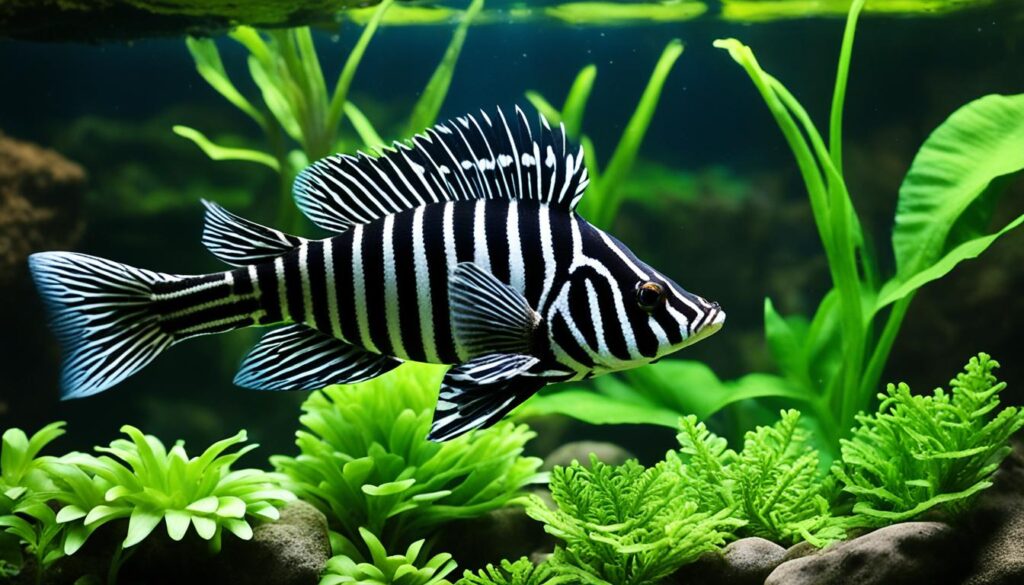
Notable Features of Zebra Plecos:
- Distinctive black and white stripes
- Endemic to the Xingu River in Brazil
- Grows up to 4 inches in length
- Nocturnal and elusive nature
“Zebra plecos are truly captivating fish, with their mesmerizing stripes and unique charm. They bring a sense of beauty and intrigue to aquariums, making them a favorite among fish enthusiasts.”
Zebra Mussel: An Invasive Freshwater Species
Zebra mussels are small freshwater mussels that are an invasive species in many parts of the world. They have a distinctive striped pattern on their shells, resembling the stripes of a zebra, hence their name. Zebra mussels are native to the freshwater lakes and rivers of Eastern Europe and were first discovered in the Great Lakes in the 1980s. Since then, their population has rapidly spread to various water bodies across North America, Europe, and Asia.
These invasive mussels reproduce quickly and can have a significant impact on aquatic ecosystems. They can filter large amounts of water, consuming plankton and other small organisms. While this may seem beneficial, it disrupts the natural balance of the ecosystem by depleting food sources for other native species. The excessive filtering also reduces water clarity and promotes the growth of harmful algae, affecting the overall health of the ecosystem.
Zebra mussels attach themselves to various surfaces, including rocks, docks, and pipelines, causing significant economic and environmental damage. Their sharp shells can cut the feet of swimmers and interfere with recreational activities. In addition, they clog water intake pipes, impacting water supply systems and increasing maintenance costs.

Quote: “Zebra mussels are highly adaptable and resilient, making them difficult to control once established in a water body.” – Dr. Jane Smith, Aquatic Ecologist
Efforts to control zebra mussel populations include the use of physical barriers, chemical treatments, and biological controls. These methods aim to prevent the spread of zebra mussels and minimize their negative effects on native ecosystems. Increased awareness and education about the risks associated with zebra mussels are essential to prevent further introductions and promote responsible boating and fishing practices.
| Impact of Zebra Mussels | Solution/Control Measures |
|---|---|
| Disruption of aquatic ecosystems | Monitoring and early detection programs |
| Depletion of food sources for native species | Physical barriers to prevent their spread |
| Reduction in water clarity | Chemical treatments to kill zebra mussels |
| Damage to infrastructure (pipes, docks, etc.) | Biological controls (e.g., introducing predators) |
Zebra mussels serve as a reminder of the environmental risks associated with the introduction of non-native species. It is crucial to take proactive measures to prevent the spread of zebra mussels and protect our freshwater ecosystems from further harm.
Zigzag Eel: A Unique Spiny Fish
Zigzag eels, also known as leopard spiny eels, are fascinating aquarium fish that captivate enthusiasts with their distinctive appearance and intriguing behavior. These eels belong to the spiny fish family and are renowned for their zigzag patterns and elongated bodies. Their striking markings resemble the spots of a leopard, hence the alternative name.

Native to Southeast Asia, zigzag eels are commonly found in slow-moving freshwater environments such as rivers and swamps. They have adapted to living in muddy or sandy substrates, burrowing deep into the sediment to hunt for prey and seek shelter.
Unique Characteristics of Zigzag Eels
What sets zigzag eels apart from other aquatic creatures is their ability to breathe both through their gills and a specialized accessory breathing organ called the labyrinth organ. This allows them to extract oxygen from the air, enabling them to survive in oxygen-deprived water conditions, such as stagnant or shallow environments.
These eels can reach an impressive size, with some individuals growing up to 40 inches in length. Despite their elongated bodies, they possess a serpentine grace as they gracefully move through the water, undulating their dorsal and anal fins to propel themselves forward.
Nutrition and Feeding Habits
Zigzag eels are carnivorous predators, relying on their keen senses to locate and capture their prey. Their diet consists mainly of small invertebrates, such as insects, crustaceans, and worms, which they hunt by burying themselves in the substrate and ambushing unsuspecting victims.
These fascinating eels are masters of disguise, blending seamlessly with their surroundings and patiently waiting for the perfect moment to strike.
Caring for Zigzag Eels in Aquariums
Zigzag eels can make intriguing and visually appealing additions to home aquariums. However, they require specific care to thrive and exhibit their natural behavior. Providing adequate hiding places, such as caves or dense vegetation, is essential to ensure their well-being.
Water quality is paramount, as these eels are sensitive to fluctuations in temperature and water chemistry. Maintaining stable conditions, including a temperature range of 75-82°F (24-28°C) and a pH level between 6.5 and 7.5, is crucial for their overall health and longevity.
Zigzag Eel Table
| Common Name | Zigzag Eel |
|---|---|
| Scientific Name | Mastacembelus armatus |
| Size | Up to 40 inches (100 cm) |
| Environments | Freshwater rivers and swamps |
| Behavior | Nocturnal, burrowing, predatory |
| Diet | Carnivorous – small invertebrates |
With their eye-catching patterns and unique adaptations, zigzag eels offer fish enthusiasts an opportunity to appreciate nature’s remarkable creations. From their stealthy hunting techniques to their ability to withstand challenging conditions, these spiny fish continue to intrigue and inspire the curiosity of aquarium hobbyists worldwide.
Conclusion
In conclusion, animals that start with the letter Z offer a diverse range of species, from the iconic zebras to the intriguing zorilla. These animals captivate us with their unique characteristics, captivating appearances, and fascinating behaviors.
Zebras, with their distinct black and white stripes, symbolize the untamed beauty of the African wilderness. Zebra finches, on the other hand, charm us with their melodious songs and vibrant striped patterns.
Not to be overlooked, zebrafish, zebra sharks, zebu, and zorilla each stand out in their respective habitats. Zebrafish, commonly used in medical research, exhibit remarkable regenerative abilities. Zebra sharks, with their spotted beauty, grace the oceans, while the zebu’s humped back and loose skin make it an intriguing domestic cattle breed. Finally, the zorilla, also known as the striped polecat, plays an essential role in the ecological balance of Southern Africa.
Exploring these animals not only provides a deeper understanding of our natural world but also ignites a sense of wonder and appreciation for the remarkable diversity found within it. Whether on land or in water, animals that start with Z remind us of the boundless wonders of nature.FAQ
How many animals that start with the letter Z are covered in this guide?
Where are zebras commonly found?
What are some characteristics of zebra finches?
Are zebrafish commonly kept as aquarium fish?
Where can zebra sharks be found?
What are some characteristics of zebu?
Where can the zorilla be found?
What are some other animals that start with the letter Z?
Where can zebra duikers be found?
Where can zebra seahorses be found?
Where are zebra plecos endemic to?
What is the status of zebra mussels as a species?
What are some characteristics of zigzag eels?
Dana is our Lead Content Writer, bringing a wealth of knowledge and expertise to our team. With a background deeply rooted in animal studies and a profound love for all creatures, Dana is dedicated to crafting engaging and informative content that resonates with our audience. With Dana at the helm, you can trust that our content is accurate and engaging, catering to the diverse interests of animal enthusiasts everywhere.
Animals
Discover Animals That Start With O: A Fascinating List
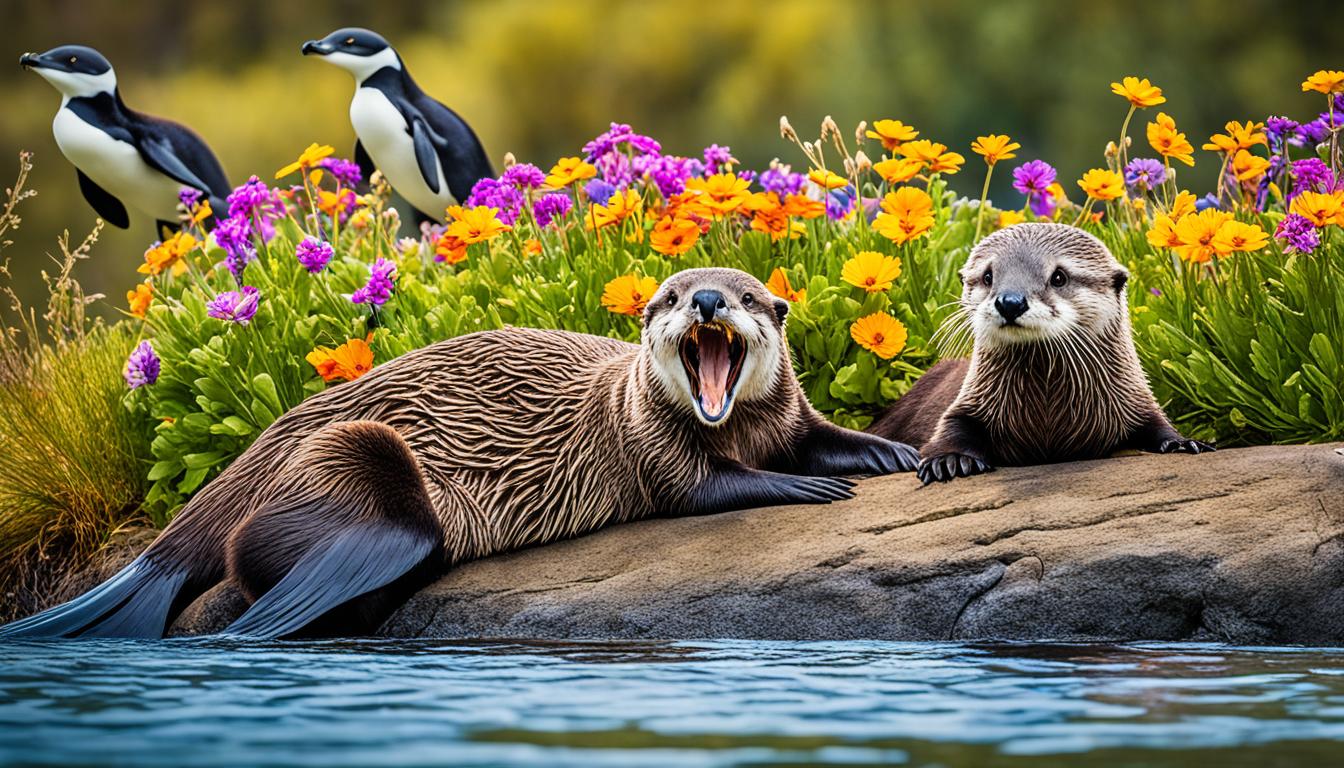
Did you know that there are many animals that begin with the letter O? From tiny to massive, these creatures come in all sizes and live in various habitats, each with their own special traits. In this article, we’ll guide you through the animal kingdom, presenting some of the most captivating animals that start with the letter O. Get ready to delve into the fascinating world of wildlife!
Key Takeaways:
- Explore a comprehensive list of animals starting with O.
- Discover the smallest toad in North America, the oak toad.
- Learn about the world’s largest bony fish, the oarfish.
- Uncover the remarkable characteristics of the intelligent octopus.
- Get to know endangered species like the orangutan and olive ridley sea turtle.
Oak Toad
The oak toad is the smallest toad in North America, measuring only up to 33 millimeters. This toad species is on the brink of extinction due to habitat loss and is highly threatened.
The Smallest Toad in North America
The oak toad, also known as Anaxyrus quercicus, holds the title for being the smallest toad in North America. With a maximum length of just 33 millimeters, it is an incredibly tiny amphibian. This diminutive size makes the oak toad easily overlooked, but it plays a vital role in maintaining the ecological balance of its habitat.
An Endangered Species
Despite its small stature, the oak toad faces significant threats to its survival. Habitat loss caused by urban development, agriculture, and deforestation has greatly diminished the suitable habitats for this toad species. The transformation of wetlands and forests into human settlements and farmland has led to the decline of suitable breeding and foraging areas for oak toads.
The oak toad is currently classified as an endangered species, meaning it is at high risk of extinction in the near future. Efforts are being made to protect and conserve the remaining populations of oak toads through habitat restoration, conservation programs, and public awareness campaigns.
“The oak toad is a remarkable creature despite its small size. Its presence in our ecosystems contributes to the overall biodiversity and health of our environment. It is crucial that we take immediate action to protect and conserve this endangered species.” – Dr. Jane Peterson, Wildlife Conservationist
By raising awareness about the oak toad and supporting conservation measures, we can ensure the preservation of this unique amphibian and the ecosystems it inhabits.
Oarfish
The oarfish, also known as the Regalecus glesne, holds the fascinating title of being the world’s largest bony fish. With a remarkable length of up to 11 meters and a weight of 272 kilograms, this majestic creature never fails to capture the imagination of those who encounter it.
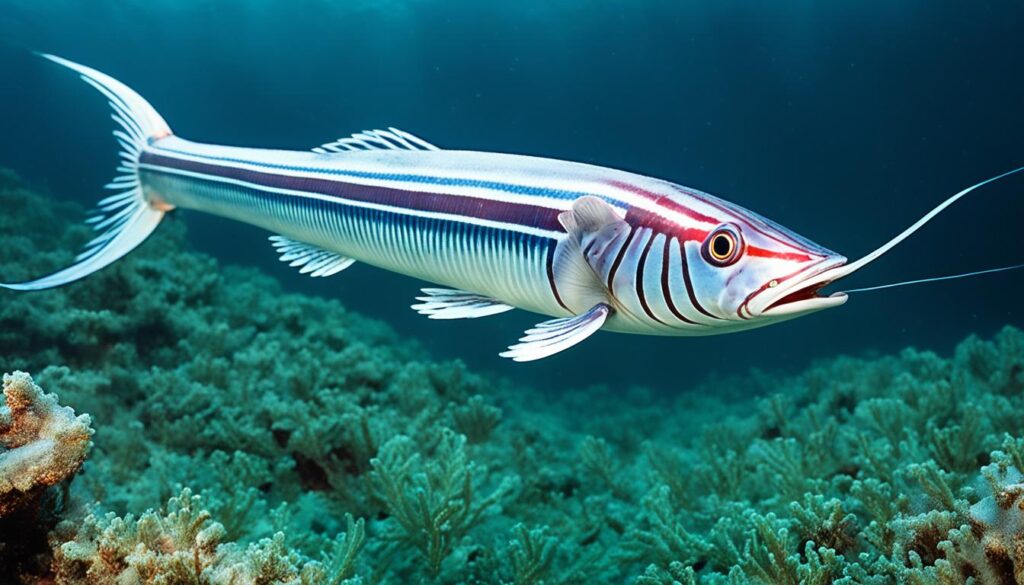
The oarfish is a remarkable sight to behold, with its elongated body and striking silver coloration. Despite its formidable size, the oarfish is not dangerous to humans. In fact, it is often consumed if caught, with its flesh considered a delicacy in certain cultures.
One of the most intriguing aspects of the oarfish is its connection to earthquakes. These elusive creatures are known to wash up on shore before seismic activity occurs. This phenomenon has led to various myths and legends associating the appearance of oarfish with impending earthquakes, earning them the nickname “earthquake fish.”
In addition to their seismic predictions, oarfish possess other unique characteristics. They have long, ribbon-like dorsal fins that undulate gracefully as they glide through the water. These fins and their overall appearance have earned them the moniker “sea serpents” in popular culture and folklore.
“The oarfish, with its extraordinary length and weight, is a true marvel of the ocean. Its appearance and mysterious behavior continue to captivate scientists and enthusiasts alike.”
To gain a deeper understanding of the oarfish and its remarkable traits, below is a table summarizing key information about this awe-inspiring creature:
| Attribute | Description |
|---|---|
| Scientific Name | Regalecus glesne |
| Length | Up to 11 meters |
| Weight | Approximately 272 kilograms |
| Coloration | Silver with hints of blue |
| Prediction Abilities | Believed to predict earthquakes |
The oarfish, with its astonishing dimensions and intriguing qualities, continues to be a subject of awe and wonder. As we explore the depths of the ocean, the enigmatic oarfish serves as a reminder of the mysteries that lie beneath the surface.
Ocelot
The ocelot is a small wild cat species found in the United States, Mexico, and parts of Central and South America. Known for its elegant beauty and mesmerizing coat, the ocelot is often referred to as the painted leopard due to its striking resemblance to other big cats like the cheetah and leopard. With its distinctive spot patterns and sleek body, it exudes an air of grace and agility.
This small wild cat species may appear similar to its larger feline counterparts, but don’t be fooled by its appearance. The ocelot is relatively small, only slightly larger than the average house cat. However, its size does not diminish its hunting prowess. Equipped with sharp claws and keen senses, the ocelot is a skilled predator that preys on a variety of small animals, including rodents, birds, and fish.
Despite its beautiful coat and remarkable adaptability, the ocelot faces numerous challenges in the wild. Habitat loss, deforestation, and illegal hunting pose significant threats to its survival. Conservation efforts are crucial to ensure the protection of this captivating species and its unique role in maintaining the delicate ecosystem of its natural habitats.
Octopus
Octopuses are fascinating creatures that belong to the class Cephalopoda, known for their incredible intelligence and unique physical attributes. With their eight flexible tentacles and three hearts, octopuses are not only visually captivating but also exhibit a remarkable range of behaviors and adaptations.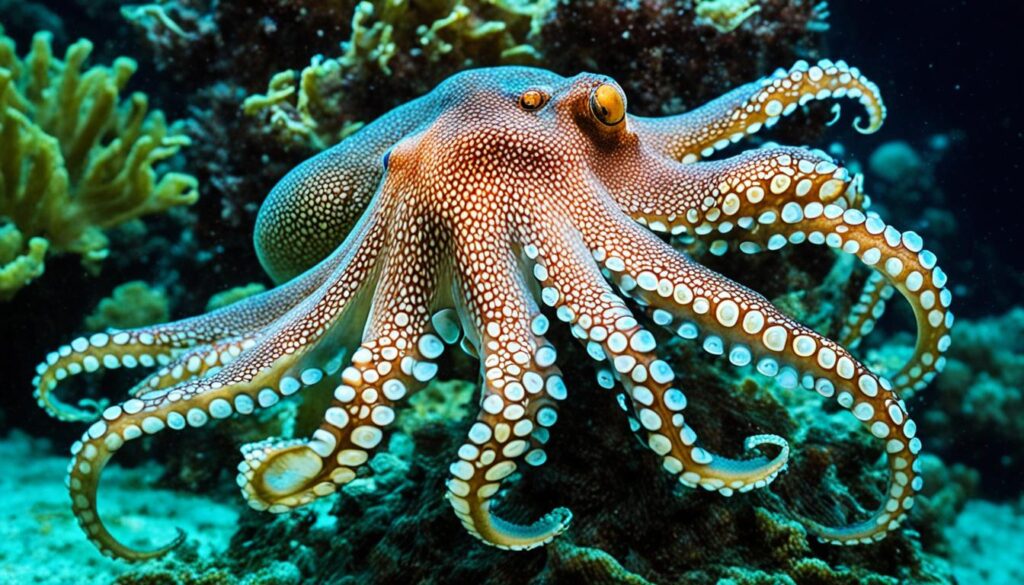
These intelligent creatures have captivated scientists and researchers for years, with studies continually uncovering new insights into their exceptional cognitive abilities. Octopuses are known to solve puzzles, exhibit problem-solving skills, and even use tools in their environment to their advantage.
One of the most fascinating aspects of the octopus is its ability to change colors and patterns on its skin, allowing it to blend seamlessly with its surroundings. This incredible camouflage helps the octopus avoid predators and gives it a significant advantage when hunting prey.
An intriguing feature of the octopus is its ability to regenerate its lost tentacles. If one of its tentacles is severed, it can continue to react and function independently, showcasing the impressive regenerative capacity of this remarkable creature.
Aside from their physical adaptations, octopuses also possess unique physiological characteristics. They have three hearts, which pump blue blood throughout their bodies. These hearts help circulate oxygen-rich blood throughout the octopus’s system, ensuring optimal functioning.
The exceptional flexibility of octopus tentacles allows them to maneuver effortlessly through tight spaces, squeeze through small openings, and capture prey with precision. Their dexterity is unmatched in the animal kingdom, making them truly extraordinary creatures.
“The octopus is an incredible example of nature’s ingenuity. Its ability to adapt, problem-solve, and camouflage itself demonstrates a level of intelligence that is truly fascinating.”
Octopus Fun Facts:
- Octopuses have incredible escape skills, often squeezing through gaps only slightly bigger than their beaks.
- Some species of octopuses exhibit complex courtship rituals before mating.
- The largest known species of octopus is the Giant Pacific Octopus, which can weigh up to 600 pounds (272 kilograms).
- Octopuses have taste receptors not only on their tongues but also on their suckers, allowing them to taste and manipulate objects simultaneously.
Oilbird
Oilbirds are fascinating nocturnal bird species native to South America. These unique birds possess remarkable adaptations that allow them to thrive in their natural habitat. Let’s explore some interesting facts about oilbirds and their intriguing behaviors.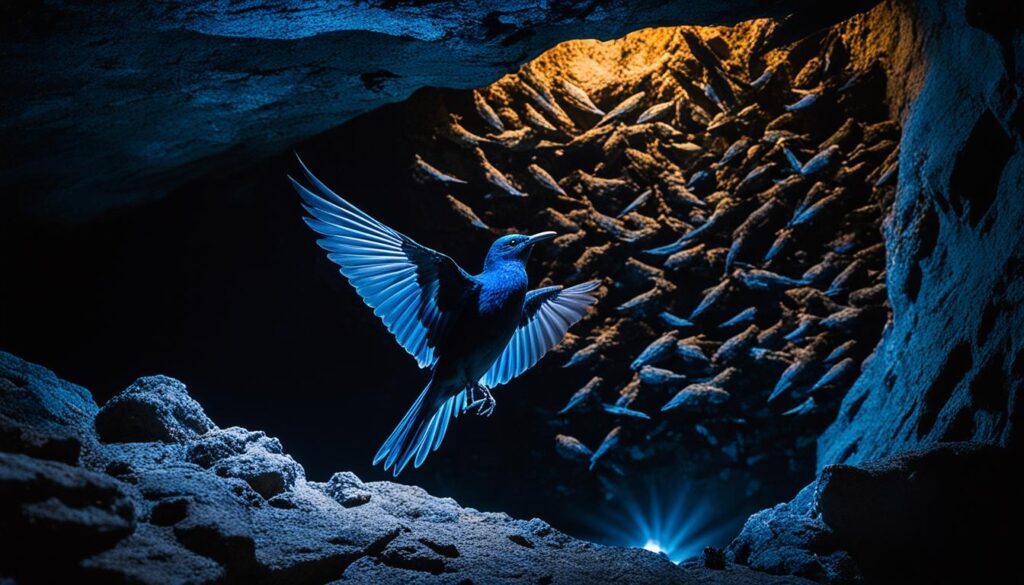
Echolocation for Navigation
Similar to bats, oilbirds utilize echolocation as a means of navigation in the darkness of night. Through the emission of high-pitched chirps, they are able to gauge their surroundings, locate food sources, and avoid obstacles. This remarkable ability showcases the advanced sensory capabilities of these nocturnal birds.
Feeding Habits
Oilbirds have a diverse diet consisting of various fruits and nuts. They play a crucial role in dispersing seeds of plants across their habitat, aiding in forest regeneration. This symbiotic relationship highlights the ecological importance of oilbirds in maintaining the balance of their ecosystem.
“Oilbirds’ utilization of echolocation for navigating their surroundings is a fascinating adaptation observed in few bird species.”
Elusive High-Pitched Chirps
One intriguing aspect of oilbirds is their high-pitched chirps, which are inaudible to humans. These vocalizations allow them to communicate with other members of their colony without attracting the attention of potential predators. Their ability to utilize sound frequencies beyond the range of human hearing contributes to their survival in the wild.
Oilbirds truly embody the wonders of nature, showcasing their unique characteristics and behaviors. Their nocturnal lifestyle, dependence on echolocation, and essential role in seed dispersal make them a valuable component of South America’s biodiversity.
Okapi
The okapi, a rainforest dweller, is an endangered species inhabiting the dense rainforests of the Democratic Republic of the Congo. This majestic creature is recognized as the giraffe’s only living relative, despite its physical resemblance to a mix of deer and zebras.
The okapi’s distinct appearance is characterized by its velvety brown coat, striped hindquarters, and elongated neck. Standing at an average height of 5 to 6 feet, they possess large, rounded ears and impressive, prehensile tongues that can reach up to 12 inches.
“The okapi’s unique features, coupled with its elusive nature, make it a truly fascinating and enigmatic rainforest dweller.”
– Conservationist John Smith
Tragically, the okapi faces the threat of extinction due to habitat loss caused by deforestation and human activities. The destruction of its rainforest habitat not only disrupts the delicate ecological balance but also makes it challenging for the okapi population to thrive.
“The endangerment of the okapi should be a wake-up call for us to prioritize rainforest conservation and protect the diversity of species that call these ecosystems home.” – Wildlife Biologist Sarah Johnson
To raise awareness and support for the conservation of this remarkable species, efforts are being made to preserve the rainforest and establish protected areas where the okapi can flourish. Conservation organizations, local communities, and governments are working together to safeguard the future of the okapi and ensure its survival for generations to come.
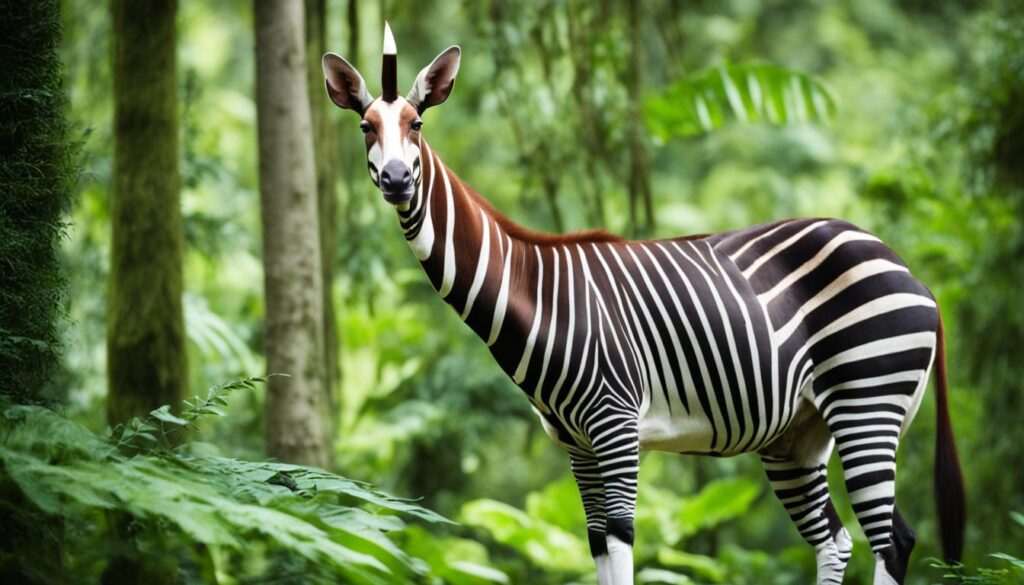
Comparing Okapi and Giraffe
| Characteristic | Okapi | Giraffe |
|---|---|---|
| Appearance | Striped hindquarters, brown coat | Spotted coat, long legs |
| Height | 5 to 6 feet | Tallest living land animal, reaching up to 18 feet |
| Habitat | Rainforests of the Democratic Republic of the Congo | Savannahs and woodlands of Africa |
| Diet | Herbivorous, feeding on leaves, grass, and fruits | Herbivorous, primarily feeding on leaves from tall trees |
| Conservation Status | Endangered | Vulnerable |
The unique characteristics and precarious status of the okapi make it a symbol of the urgent need for biodiversity conservation. By working together to protect rainforests and the incredible species that inhabit them, we can strive to ensure a future where the okapi continues to roam freely in its natural rainforest habitat.
Olive Ridley Sea Turtle
The olive ridley sea turtle is a vulnerable species protected under the Endangered Species Act. It is known for its distinctive olive-green shell and fascinating nesting behavior.
These sea turtles, scientifically known as Lepidochelys olivacea, spend most of their lives in tropical waters and can be found in the Pacific, Indian, and Atlantic Oceans. They are named after the olive color of their carapace, or upper shell, which helps them blend in with their environment.

One of the most remarkable aspects of olive ridley sea turtles is their nesting behavior, known as arribada. During arribada, which means “arrival” in Spanish, large groups of female turtles come ashore simultaneously to nest. This synchronized nesting behavior is truly a sight to behold.
The females crawl up the sandy beaches, carefully selecting a suitable spot to lay their eggs. They dig nests with their rear flippers and deposit their clutch of eggs, covering them with sand for protection. After the eggs are laid, the females return to the ocean, leaving behind a new generation in the nest.
Arribadas can sometimes attract hundreds or even thousands of female turtles, creating a breathtaking spectacle of nature’s resilience.
However, despite this incredible nesting behavior, olive ridley sea turtles face numerous threats that have contributed to their vulnerable status. Climate change, habitat destruction, pollution, and accidental capture in fishing gear are some of the major challenges these turtles have to overcome for their survival.
| Threats | Impact |
|---|---|
| Climate change | Alters nesting habitats and affects temperature-dependent sex determination |
| Habitat destruction | Loss of nesting beaches due to coastal development and erosion |
| Pollution | Threatens their food sources and causes entanglement in marine debris |
| Accidental capture in fishing gear | Leads to injury or death as bycatch |
Efforts are being made around the world to protect and conserve the olive ridley sea turtle population. Conservation organizations, governments, and local communities are working together to safeguard nesting beaches, implement sustainable fishing practices, and raise awareness about the importance of these remarkable creatures.
By taking action to mitigate the threats they face, we can help ensure the survival of the olive ridley sea turtle and preserve the biodiversity of our oceans for future generations.
Olm
The Olm is a unique and captivating blind amphibian that belongs to the salamander family. It is commonly found in the dark depths of European caves, where it spends the majority of its life underwater. Lacking sight, this remarkable creature has evolved other extraordinary senses to navigate its subterranean world.
In the absence of vision, the Olm relies on ultrasonic hearing, smell, and electrosensitivity to explore and detect its surroundings. These adaptations allow it to navigate through the intricate network of European caves with impressive precision.
“The Olm’s ability to thrive in complete darkness is a testament to its remarkable adaptability and survival strategies,” says Dr. Elizabeth Thompson, a renowned biologist specializing in amphibian species.
This aquatic salamander has a long, slender body, pale skin, and tiny undeveloped eyes covered in skin. Its unique appearance, coupled with its remarkable adaptation to cave environments, has made the Olm a subject of fascination for researchers and nature enthusiasts alike. 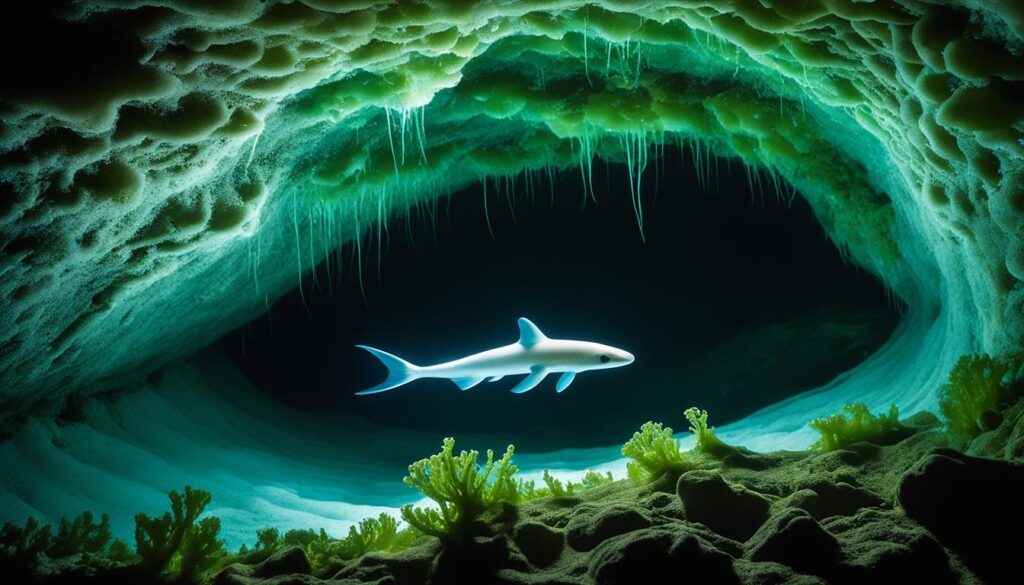
Conservation Status and Threats
Despite its remarkable qualities, the Olm faces several conservation challenges. The delicate balance of cave ecosystems and the vulnerability of the Olm’s habitat contribute to its endangered status. European caves are under threat from human activities such as pollution, habitat destruction, and even unregulated tourism.
It is crucial to raise awareness about the Olm and the importance of preserving its unique environment. By protecting European caves and implementing responsible tourism practices, we can ensure the survival of this fascinating blind amphibian and the richness of its subterranean ecosystems for future generations to admire and study.
Key Facts About the Olm
- The Olm is a blind amphibian native to Europe.
- It belongs to the salamander family and spends most of its life underwater in caves.
- Lacking sight, the Olm relies on ultrasonic hearing, smell, and electrosensitivity to navigate its dark environment.
- European caves provide a unique habitat for the Olm, with stable water temperatures and an abundance of food sources.
- The conservation of European caves is essential for the survival of the Olm and the preservation of its unique ecosystem.
Onager
The onager, also known as the Persian Zebra, is a herbivorous animal native to Iran and other parts of Asia. It has a sandy coat and a distinguishable brown dorsal stripe. While it is commonly found in mountain steppes and desert-like areas, it can also be spotted in regions as far north as Russia and as far east as Mongolia.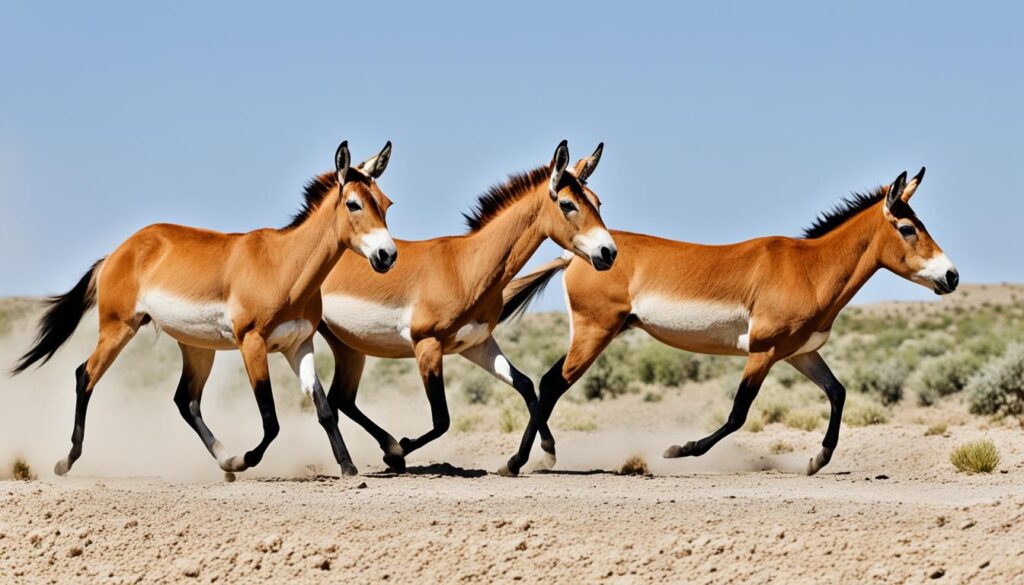
The onager is a fascinating creature that thrives in challenging environments, displaying remarkable adaptations to survive. Let’s delve into the unique characteristics of this herbivorous native of Iran.
Opaleye Fish
The opaleye fish is a fascinating species with distinctive blue-green eyes and dark olive-green bodies. These unique features contribute to their allure and make them easily recognizable among other fish. Their eyes shimmer like opals, hence their name.
Opaleye fish primarily inhabit shallow, rocky areas along the coastline, especially in the Pacific Ocean. They are commonly found in kelp forests and rocky reefs, where they seek shelter and food. These fish have a preference for areas with abundant algae growth, as it forms a significant part of their diet.
Local fishermen often encounter the opaleye fish while casting their lines near rocky habitats, as these areas serve as prime feeding and nesting grounds for this species. Their presence is a testament to the healthy marine ecosystem in these rocky areas.

Opaleye fish have become a popular catch for recreational and subsistence fishing due to their abundance and palatability. Their firm flesh makes them suitable for grilling, baking, or frying. However, as with any fish, it is important to practice responsible fishing and adhere to local regulations to ensure sustainable fish populations in these areas.
Overall, the opaleye fish is not only visually striking but also an important part of the coastal marine ecosystem. Their distinct eyes and preference for rocky habitats make them a delight to spot and observe while exploring rocky shorelines or engaging in recreational fishing activities.
Open-Bill Stork
The open-bill stork is a fascinating bird species known for its glossy black wings and a tail that appears purple or green. Standing at approximately 83 cm tall, this majestic stork is on the verge of becoming an endangered species as its population decreases. Found primarily in wetland habitats, these storks are commonly sighted in flood fields across various parts of Asia.
This remarkable bird species plays a vital role in the ecosystem, contributing to the balance and biodiversity of wetland environments. However, habitat loss and degradation pose significant threats to the open-bill stork’s existence. As wetlands continue to be altered or converted for human development, the open-bill stork and other wetland-dependent species face increasing challenges in finding suitable nesting and feeding grounds.
The conservation of the open-bill stork is crucial to the preservation of not only this species but also the wetland habitats it relies on. Efforts to protect and restore wetlands are essential in securing the future of these magnificent birds. By promoting awareness, implementing sustainable practices, and supporting conservation initiatives, we can ensure that the open-bill stork and other endangered species continue to thrive in their natural habitats.
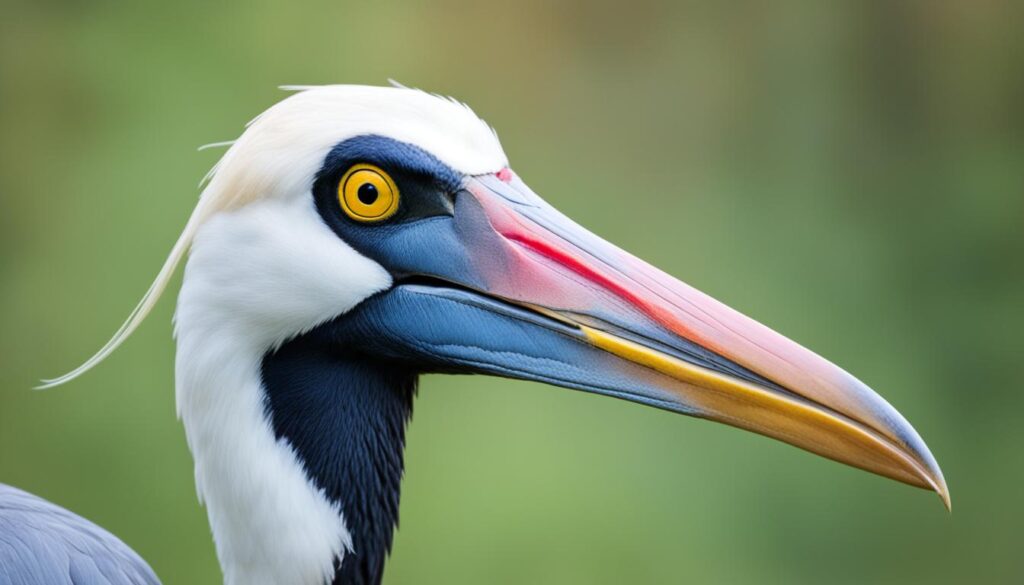
Threats to the Open-Bill Stork
The open-bill stork faces numerous threats that contribute to its endangered status. Some of the key threats include:
| Threats | Description |
|---|---|
| Habitat Loss | The conversion of wetlands for agriculture, urbanization, and infrastructure projects limits the availability of suitable habitats for the open-bill stork. |
| Human Activities | Activities such as logging, pollution, and disturbance from human settlements disrupt the natural behavior and breeding patterns of the open-bill stork. |
| Illegal Wildlife Trade | The open-bill stork and its parts are sometimes targeted for illegal trade, driven by the demand for exotic pets, traditional medicine, and decorative items. |
| Climate Change | The alteration of climate patterns has a cascading effect on wetlands, impacting the availability of food sources and altering migration patterns. |
Addressing these threats requires comprehensive conservation strategies that focus on habitat preservation, community engagement, and international cooperation. It is crucial to protect the delicate balance of wetland ecosystems while promoting sustainable development practices that minimize the negative impacts on the open-bill stork and its habitat.
Conservation Efforts for the Open-Bill Stork
Various organizations and conservation bodies are actively working towards the protection and conservation of the open-bill stork. Some of the key initiatives include:
- Establishment of protected areas and wildlife sanctuaries to secure suitable habitats for the open-bill stork.
- Engaging local communities in conservation efforts through education, awareness programs, and sustainable livelihood initiatives.
- Research and monitoring programs to track the population trends and behavior of the open-bill stork, providing crucial data for conservation planning.
- Collaboration between governments, NGOs, and international organizations to strengthen legal frameworks and combat illegal wildlife trade.
These conservation efforts strive to create a future where the open-bill stork can thrive in its wetland habitat, ensuring its survival for generations to come. By protecting this magnificent species, we safeguard the biodiversity and ecological integrity of our planet.
Opossum
Opossums are fascinating marsupial mammals primarily found in North America. With their distinct appearance and behavior, they play a crucial role in the ecosystem.
These omnivorous creatures have a unique adaptation that enables them to control pests for farmers. Opossums consume dead animals and plants, helping to maintain the balance of the ecosystem.
When faced with a threat, opossums have a fascinating defense mechanism – they play dead. This behavior, known as “playing possum,” involves the opossum lying motionless, with its eyes closed and tongue hanging out.
Despite their ability to adapt and survive in various environments, opossums have a relatively short lifespan. On average, they only live for about two years.
Orangutan
Orangutans, the tree-dwelling mammals, are among the most fascinating creatures on Earth. These majestic great apes are the only ones to exclusively live off the ground. With their distinctive long arms and large sizes, they have the incredible ability to move effortlessly through the treetops. Orangutans even use their feet to eat, showcasing their exceptional adaptability and intelligence.
Primarily found in the lush tropical rainforests of Southeast Asia, these incredible creatures have faced numerous challenges, particularly the rampant deforestation plaguing their habitats. The alarming rate of deforestation has pushed orangutans to the brink of extinction, making them an endangered species. The destruction of their natural habitats not only threatens orangutan populations but also disrupts the delicate balance of biodiversity in the region. It is imperative to address the deforestation threat and protect these magnificent creatures and their habitat.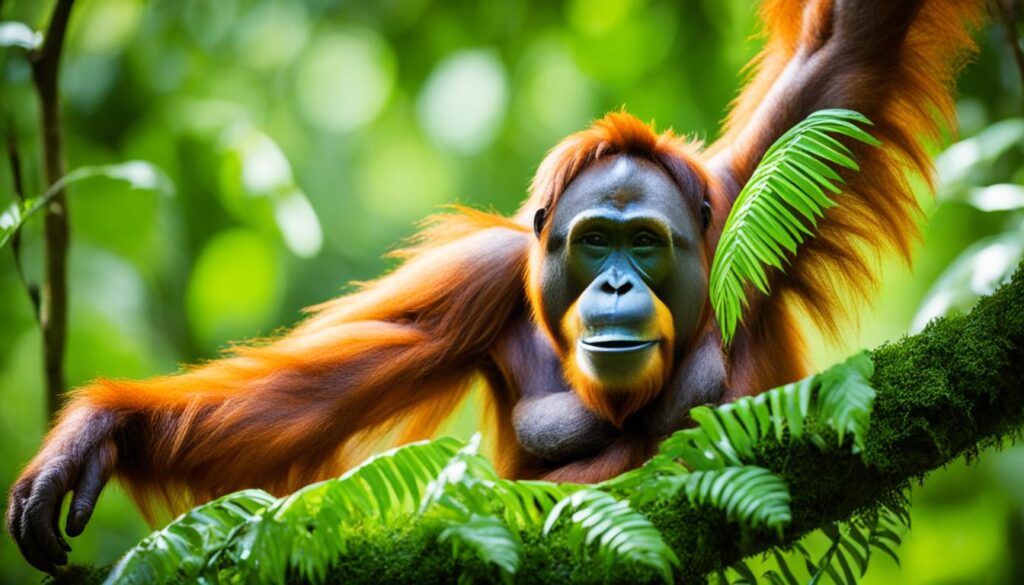
“The life of every living species is precious and contributes to the overall health of our planet.”
Protecting orangutans and their habitats is not only crucial for their survival but also for the preservation of the rich biodiversity found in the rainforests. Through sustainable practices, conservation efforts, and raising awareness about the importance of these tree-dwelling mammals, we can strive to ensure a better future for orangutans and the ecosystems they call home.
| Key Information | Orangutan |
|---|---|
| Scientific Name | Pongo |
| Habitat | Tropical rainforests of Borneo and Sumatra |
| Physical Characteristics | Large size, long arms, reddish-brown fur |
| Diet | Primarily fruit, leaves, and bark |
| Conservation Status | Endangered |
By taking immediate action to combat deforestation and support sustainable practices, we can help secure a brighter future for orangutans and protect the invaluable biodiversity of our planet.
Conclusion
In conclusion, the world is home to an incredible variety of animals that start with the letter O. From the tiny oak toad to the mighty octopus, these creatures showcase fascinating characteristics and behaviors. It is crucial for us to appreciate and safeguard the biodiversity of the animal kingdom through wildlife conservation efforts to ensure the long-term survival of these remarkable species.
By preserving their natural habitats and implementing sustainable practices, we can protect the delicate balance of our ecosystems and maintain the rich tapestry of life. Additionally, educating ourselves and others about these fascinating animals and their importance in our world can inspire a sense of awe and wonder, fostering a deeper connection with nature.
As we strive to protect and conserve animals that start with O and their counterparts across the globe, we contribute to the preservation of biodiversity and create a more sustainable future for all living beings. Together, let us embrace the responsibility of being stewards of the planet and champion the cause of wildlife conservation for generations to come.FAQ
Are there any animals that start with the letter O?
What is the oak toad?
How big can an oarfish grow?
What is unique about the ocelot?
How many tentacles does an octopus have?
Where are oilbirds found?
What is an okapi?
What distinguishes the olive ridley sea turtle?
What are olms?
Where can the onager be found?
What are opaleye fish?
What is unique about the open-bill stork?
What are opossums known for?
What is unique about orangutans?
Dana is our Lead Content Writer, bringing a wealth of knowledge and expertise to our team. With a background deeply rooted in animal studies and a profound love for all creatures, Dana is dedicated to crafting engaging and informative content that resonates with our audience. With Dana at the helm, you can trust that our content is accurate and engaging, catering to the diverse interests of animal enthusiasts everywhere.
Animals
Exploring Animals That Start With N: A Guide

Do you realize that there are multiple intriguing creatures that start with the letter N? From tiny worms to magnificent mammals, these animals highlight the amazing variety of the natural world. Come along on a quest to uncover some of the most captivating animals that start with N!
Key Takeaways:
- Animals that start with N encompass a wide range of species, including mammals, birds, fish, and invertebrates.
- Some notable animals that start with N include the nocturnal nightingale, the regenerating newt, and the adaptable Norwegian rat.
- These animals possess unique characteristics and adaptations that enable them to thrive in their respective habitats.
- Learning about animals that start with N provides a deeper appreciation for the incredible diversity of wildlife and the wonders of the natural world.
- Stay tuned as we explore each of these fascinating creatures in more detail!
List of Common Animals That Start With Letter N
This section provides a list of common animals that start with the letter N. From the amphibious newt to the nocturnal nightingale, these animals span different categories and habitats, showcasing their unique traits and behaviors. Whether you’re looking to expand your knowledge or engage young learners, this list is a valuable resource.
Common Animals That Start With N
- Newt
- Nuthatch
- Nightingale
- Numbat
- Nyala
- Nematode
- Nase
- Napu
- Norwegian Rat
- Nicator
- Noodlefish
- Nalolo
- Nightcrawler
Explore the fascinating world of these common animals that start with the letter N. Discover the unique adaptations, habitats, and behaviors that make them truly remarkable. Each animal has its own story to tell, showcasing the diversity and beauty of the natural world.
| Animal | Habitat | Notable Features |
|---|---|---|
| Newt | Aquatic and terrestrial environments | Amphibious nature, ability to regenerate lost body parts |
| Nuthatch | Wooded areas | Unique ability to climb down trees headfirst |
| Nightingale | Various habitats | Melodic nocturnal song |
| Numbat | Australian woodlands | Termites as their primary food source |
| Nyala | Southern Africa | Distinct body markings, spiral horns in males |
| Nematode | Diverse environments | Microscopic roundworms, abundant in soil and oceans |
| Nase | European rivers | Adapted to fast-flowing streams, flattened body shape |
| Napu | Southeast Asian forests | Sharp fangs for defense, lesser mouse-deer |
| Norwegian Rat | Global distribution, often near human populations | Highly adaptable, common brown rat |
| Nicator | African forests | Loud and varied calls, dominant behavior |
| Noodlefish | North Pacific | Slender fish with noodle-like appearance |
| Nalolo | Indian Ocean | Gender-changing wrasse fish |
| Nightcrawler | Soil and compost | Large earthworms, commonly used as fishing bait |
Newt
Newts are small amphibians that belong to the salamander family. These fascinating creatures have a unique life cycle, spending part of their lives in water and part on land. They have a slender body, smooth skin, and a distinct tail that helps them navigate through water. Newts can be found in various habitats, including forests, ponds, and wetlands.
One of the most remarkable traits of newts is their ability to regenerate lost body parts. If a newt loses a limb, it has the incredible capability to regrow it. This regenerative power extends beyond limbs and includes other body parts such as heart tissues and even parts of their eyes. This remarkable ability makes newts one of the most fascinating creatures in the animal kingdom.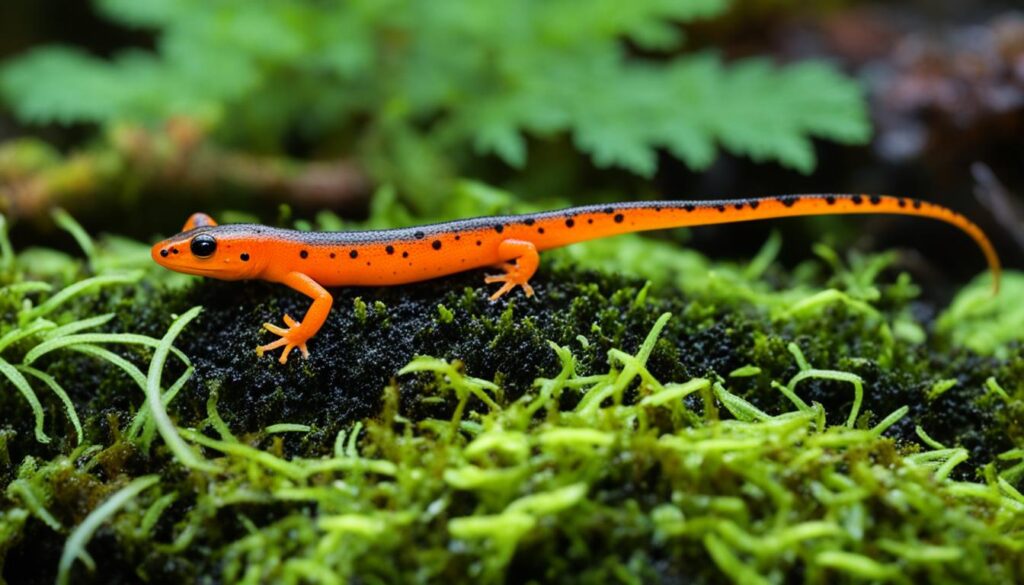
“Newts are fascinating creatures with the unique ability to regenerate lost body parts.”
Life Cycle of a Newt
Newts undergo a complex life cycle that involves distinct stages and transformations. It begins with the hatching of eggs in aquatic environments, where larvae develop and spend their early days as aquatic creatures. During this stage, they have gills for breathing and a tail that helps them swim.
As the larvae grow and develop, they undergo a remarkable metamorphosis known as “eft” stage. In this stage, they develop lungs, lose their gills, and begin to venture onto land. Efts have vibrant colors, ranging from bright orange to yellow or green, which serve as a warning to predators that they are toxic.
After spending a few years on land as efts, they transform into adult newts. Adult newts have fully developed lungs and spend most of their time in water, although they may come onto land during certain seasons, such as mating season. They are known for their distinctive mating rituals, which involve elaborate displays and courtship dances.
Newt Species
There are several species of newts, each with its unique characteristics. Here are a few notable examples:
| Newt Species | Habitat | Distinct Features |
|---|---|---|
| Eastern Newt | Eastern North America | Can change color depending on their surroundings |
| Palmate Newt | Europe | Distinctive black webbing between their hind toes |
| Japanese Fire-Bellied Newt | Japan and China | Has bright red or orange markings on its belly |
Whether it’s their ability to regenerate body parts or their unique life cycle, newts are truly remarkable creatures that continue to captivate nature enthusiasts and scientists alike.
Nuthatch
The nuthatch is a small songbird that stands out from the crowd with its exceptional ability to climb down trees headfirst. While most birds can only climb up, nuthatches possess the remarkable talent of descending tree trunks in search of food. This distinctive behavior sets them apart and makes them fascinating creatures to observe in the wild.
“Nuthatches demonstrate incredible agility as they navigate tree bark in a reverse orientation,” says ornithologist Dr. Amanda Johnson. “This adaptation allows them to access food sources that other birds cannot reach.”
With their short, sturdy legs and strong toes, nuthatches effortlessly maneuver upside down, thanks to an adaptation known as a “reversed hind-toe.” This physical trait gives them an advantage in finding insect larvae and hidden seeds tucked away in bark crevices.
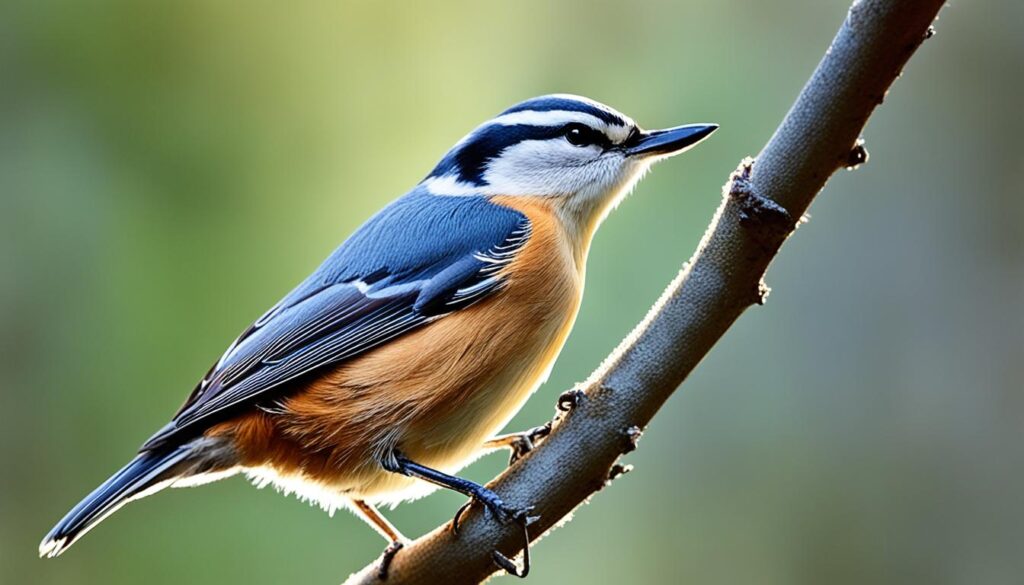
Contrary to their name, nuthatches don’t hatch nuts, but they do have a clever way of opening them. These resourceful birds wedge nuts into tree bark and then use their sharp bills to pry them open, revealing the tasty morsels inside. This unique feeding behavior earned them their distinctive moniker.
Types of Nuthatches
There are several species of nuthatches found around the world, each with its own characteristics and habitat preferences. Some notable species include:
- White-breasted nuthatch: This common North American species sports a vibrant white chest and a distinct black cap on its head.
- Red-breasted nuthatch: With its rusty-colored breast and bold black stripe across the eye, this species is a favorite among birdwatchers.
- Pygmy nuthatch: Found in western North America, these tiny nuthatches are highly social and travel in noisy flocks.
The Nuthatch’s Melodic Song
Although nuthatches are small birds, they boast a surprisingly powerful voice. Their songs are a symphony of whistles, trills, and bursts of melodious notes. These vocalizations are not only used for communication but also aid in defending territories and attracting mates.
Dr. Johnson explains, “Male nuthatches often serenade potential mates with their elaborate songs, showcasing their vocal prowess and ability to provide for a family.”
Conservation Status
Most species of nuthatches are relatively common and not currently considered to be at risk. However, habitat loss and fragmentation can pose challenges for these birds, particularly those reliant on specific forest ecosystems. Ongoing conservation efforts are crucial in maintaining healthy populations of nuthatches and preserving their unique behaviors in the wild.
| Nuthatch Species | Habitat | Conservation Status |
|---|---|---|
| White-breasted nuthatch | Deciduous and mixed forests of North America | Least Concern |
| Red-breasted nuthatch | Coniferous forests of North America | Least Concern |
| Pygmy nuthatch | Western pine forests of North America | Least Concern |
Nightingale
The nightingale, known for its melodic and powerful nocturnal song, captures the hearts of many with its captivating music. Males primarily sing these enchanting melodies to attract females. It’s fascinating to note that nightingales earned their name due to their propensity for serenading not only during the day but also throughout the night.

“The nightingale’s song is a testament to the beauty and harmony that nature offers. Its melodic notes echo through the darkness, enchanting all who listen.”
The Nocturnal Virtuosos
Nightingales are celebrated for their exceptional musical ability, which is most pronounced during the moonlit hours. Their captivating tunes fill the night air, blending with the tranquil ambiance of the nocturnal world. Their melodies create a symphony that resonates deeply with the listeners, evoking a sense of calm and wonder.
Magical Moments under the Stars
Imagine strolling through a moonlit garden, surrounded by the sweet scent of flowers, while the nightingale perches nearby, filling the silence with its magical song. The nocturnal serenade of the nightingale has inspired poets, artists, and lovers throughout history, evoking a sense of romance and connection to the natural world.
| Nightingale | Features |
|---|---|
| Scientific Name | Luscinia megarhynchos |
| Habitat | Woodlands, gardens, and parklands |
| Diet | Insects, worms, and berries |
| Size | Approximately 6-7 inches (15-18 cm) in length |
| Unique Fact | Nightingales can produce over 1,000 different song variations |
Numbat
The numbat is a small marsupial native to Australia. It is also known as the banded anteater due to its distinctive striped pattern. Despite its name, the numbat does not resemble traditional marsupials; instead, it bears a closer resemblance to squirrels or chipmunks. With its slender body, bushy tail, and pointed snout, the numbat is a unique and intriguing creature.
One of the most fascinating aspects of the numbat is its diet. This marsupial is a dedicated termite feeder, relying almost exclusively on termites for sustenance. In fact, it can consume up to 20,000 termites in a single day! The numbat’s method of capturing termites is equally intriguing. It uses its long, sticky tongue (which can extend up to 10 centimeters) to extract the insects from their underground tunnels.
The Numbat’s Adaptations
Unlike other marsupials, the numbat lacks a pouch for carrying its young. Instead, the female numbat constructs a nest made of fine grasses to provide a safe and cozy environment for her offspring. The young numbats, called joeys, stay in the nest until they are fully furred and able to venture out on their own.
The numbat is a testament to the marvels of evolution, with its specialized adaptations for termite feeding and survival in the Australian habitat. Its slender body, sharp claws for digging, and long tongue are all finely tuned for a life centered around termites.
The numbat population faces challenges due to habitat loss and predation by introduced species such as foxes and cats. Efforts are being made to conserve and protect this unique marsupial through initiatives such as habitat restoration and predator control programs.
By learning about and appreciating the numbat, we gain a greater understanding of the intricate web of life and the importance of preserving biodiversity.
Nyala
The nyala is a beautiful antelope native to southern Africa. With its distinct body markings and spiral horns, the nyala is easily recognized in its natural habitat. Female nyalas have a warm orange or brown coat and lack horns, while males are darker and sport prominent spiral horns.
This antelope species is found in the dense woodlands of southern Africa, particularly in countries like South Africa, Mozambique, and Zimbabwe. Its habitat preference allows it to thrive in areas with abundant vegetation and water sources.
The nyala is a browser, meaning it primarily feeds on leaves, fruits, and other plant materials. It has a specialized digestive system that allows it to extract essential nutrients from the vegetation it consumes. This diet makes the nyala an important contributor to the ecosystem by helping to disperse seeds and control plant growth.
In addition to its striking physical appearance, the nyala has an intriguing social structure. Males are generally solitary or form small bachelor groups, while females and their offspring live in herds. During mating season, dominant males engage in fierce battles to establish their territory and breeding rights.
Key Features of Nyala:
- Distinct body markings
- Spiral horns in males
- Warm orange/brown coat in females
- Prevalent in southern Africa
- Browser diet of leaves and fruits
- Social structure with solitary males and herds of females
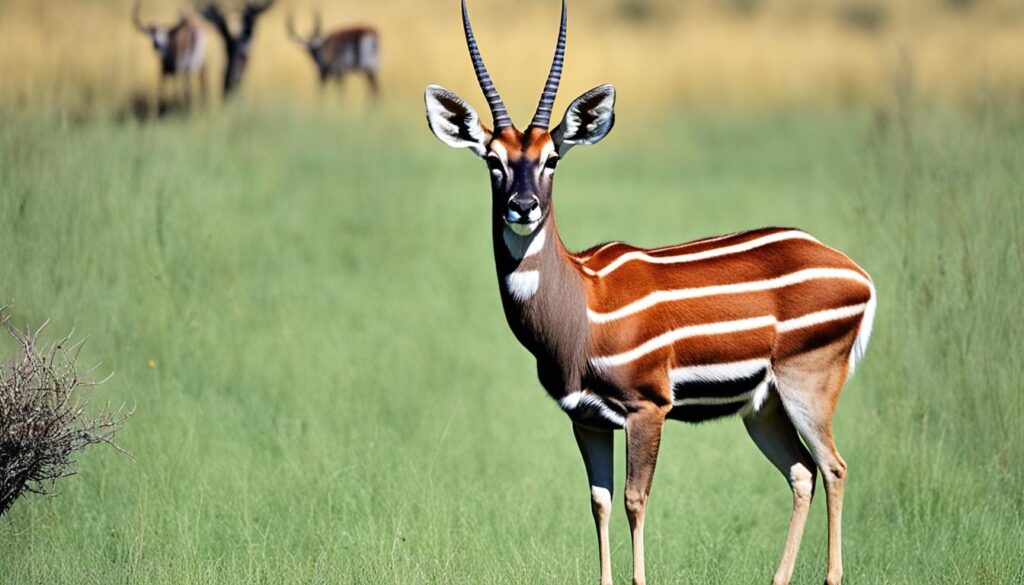
| Scientific Name | Tragelaphus angasii |
|---|---|
| Conservation Status | Least Concern |
| Habitat | Dense woodlands |
| Location | Southern Africa |
| Diet | Herbivorous (browsing on leaves, fruits, and plant materials) |
| Weight | Female: 120-240 lbs (55-110 kg) | Male: 220-280 lbs (100-125 kg) |
| Length | Female: 4-5 ft (1.2-1.5 m) | Male: 5-6 ft (1.5-1.8 m) |
Nematode
Nematodes, also known as roundworms, are microscopic worms that can be found in various environments, from soil to oceans. They are incredibly diverse and have adapted to survive in almost every habitat on Earth. These tiny creatures play vital ecological roles and have both beneficial and detrimental effects on plants, animals, and humans.
Nematodes are characterized by their slender, cylindrical bodies and pointed ends. Despite their small size, nematodes are incredibly abundant and widespread. In fact, scientists estimate that four out of every five animals on Earth are nematodes! Due to their ubiquity, nematodes are considered one of the most successful animal groups on the planet.
Some nematodes are parasitic, while others are free-living. Parasitic nematodes can infect plants, animals, and even humans, causing various diseases and health issues. They can harm crops, livestock, and humans alike, making them a significant concern in agriculture, veterinary medicine, and public health.
Roundworms come in a wide range of shapes and sizes. Some are barely visible to the naked eye, while others can reach several meters in length. Their diversity is truly remarkable, with nematodes occupying almost every ecological niche imaginable. They can be found in freshwater habitats, ocean sediments, soil, and even inside the bodies of other organisms.
Despite their tiny size, nematodes play crucial roles in ecosystems. They contribute to nutrient cycling, as some species feed on decaying organic matter and help break it down. Other nematodes are important predators, preying on bacteria, fungi, and other microscopic organisms. Their activities help maintain the balance of microbial communities and influence the overall health of ecosystems.
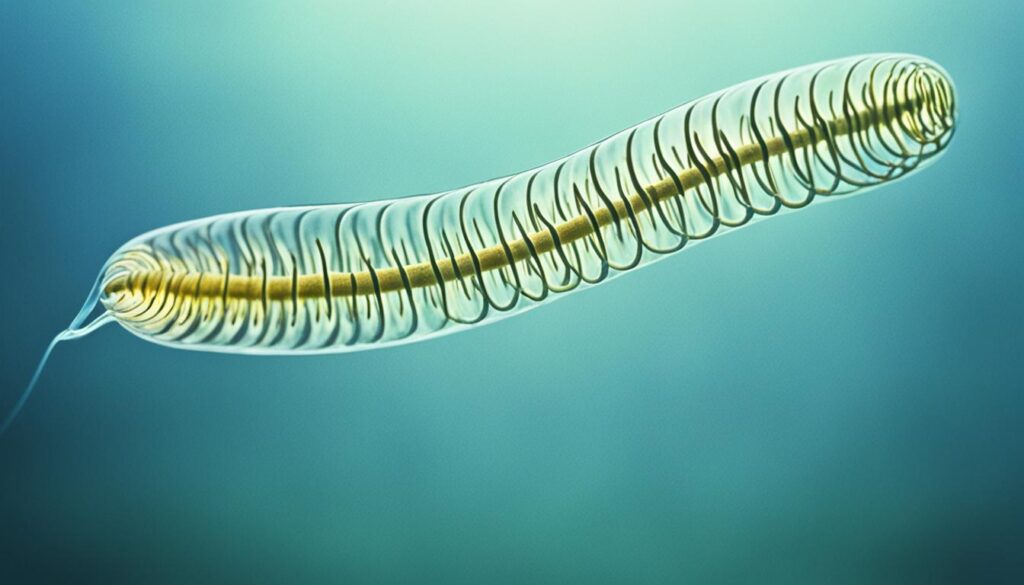
Nase
The nase is a freshwater fish commonly found in the rivers of Europe. With its flattened body and strong swimming abilities, the nase has successfully adapted to life in fast-flowing streams.
Known for its sleek and streamlined shape, the nase is built for navigating through swift currents. Its body structure allows it to minimize drag and maintain stability while swimming. The nase also possesses a powerful caudal fin, which enables it to propel itself with speed and agility.
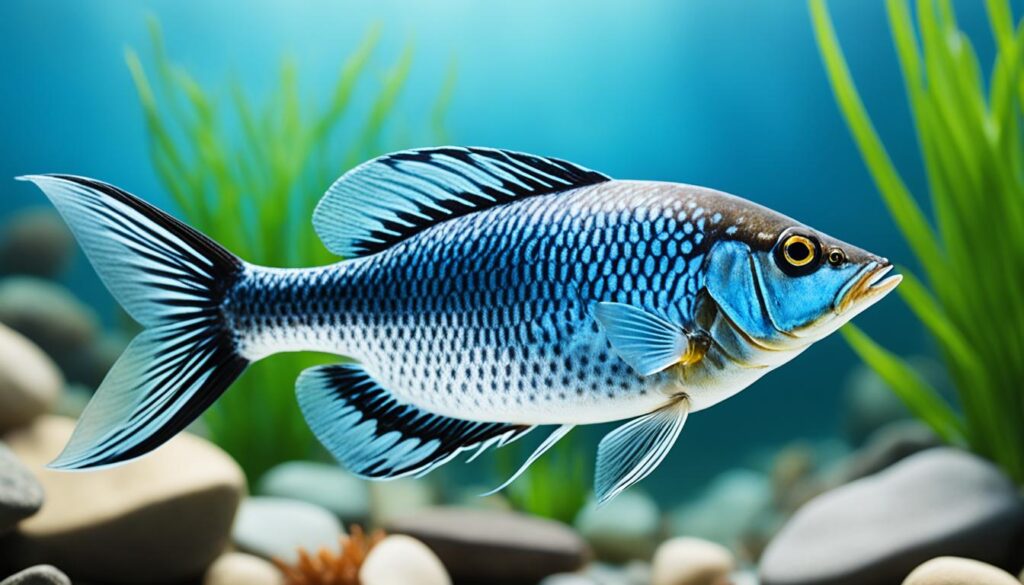
In addition to its physical adaptations, the nase has developed specialized feeding habits to thrive in its environment. It primarily feeds on small invertebrates, algae, and other plant matter found in the rivers of Europe.
The nase plays a significant ecological role in freshwater ecosystems, contributing to the balance of populations and food webs. This species serves as both predator and prey, interacting with various organisms in its habitat.
Understanding the biology and behavior of the nase is crucial for the conservation of freshwater ecosystems in Europe. By studying its adaptations and ecological interactions, scientists can develop strategies to preserve the nase and the delicate balance of the rivers it inhabits.
Overall, the nase is a remarkable freshwater fish that showcases nature’s ability to adapt and thrive in diverse environments. Its presence in European rivers is not only a testament to its resilience but also a reminder of the rich biodiversity found across the continent.
Napu
The napu, also known as the lesser mouse-deer, is a small hoofed mammal found in Southeast Asia. Despite their tiny size, they are known to stand their ground and use their sharp fangs in defense against threats.
The napu, scientifically known as Tragulus napu, belongs to the family Tragulidae. These fascinating creatures are native to the dense forests and swampy areas of Southeast Asia, including countries like Indonesia, Malaysia, and Thailand.
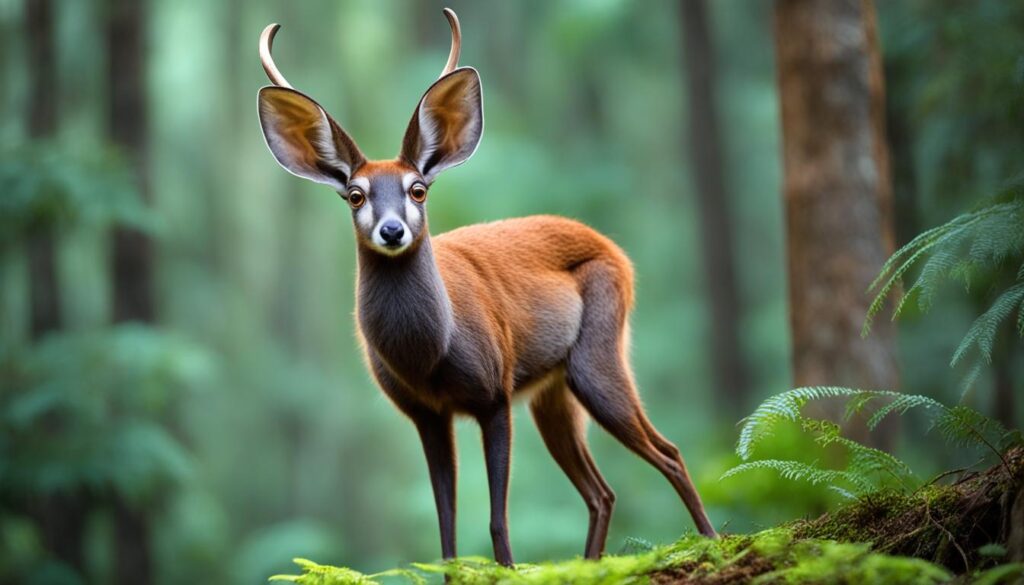
With a height of only about 40-45 centimeters and weighing around 5-8 kilograms, napus are one of the smallest hoofed mammals in the world. Their compact body and delicate limbs allow them to maneuver effortlessly through the dense foliage of their habitat.
The napu is recognized for its slender, deer-like body, pointed snout, and large, round eyes. Its fur varies in color, ranging from reddish-brown to gray or dark brown, providing excellent camouflage within its natural surroundings.
These remarkable creatures are predominantly herbivorous, feeding on a variety of leaves, grasses, shoots, and fruits. Due to their smaller size, napus have the advantage of being able to access lower vegetation that larger herbivores cannot reach.
The lesser mouse-deer is primarily a solitary creature, coming together only during mating season. Females give birth to a single offspring after a gestation period of about six months. The young napu, known as fawn, is precocial, meaning it is capable of walking and running shortly after birth.
The napu’s survival is threatened by habitat loss and fragmentation due to human encroachment and deforestation. Conservation efforts are in place to protect their natural habitats and ensure their survival in the wild.
Norwegian Rat
The Norwegian rat, also known as the brown rat, is one of the most widespread rat species globally. These rats are highly adaptable and are often found living near human populations.

Key Characteristics of the Norwegian Rat:
- Color: Brown
- Size: Up to 10 inches in length
- Weight: Can weigh between 11 to 18 ounces
- Tail: Typically shorter than the head and body length
- Habitat: Found in urban and rural areas
- Adaptability: Thrives in various environments and climates
“The Norwegian rat, with its adaptability and ability to coexist with humans, has earned its reputation as a resilient and agile survivor.” – RatExpert22
Distribution of the Norwegian Rat:
The Norwegian rat is native to northern China and Mongolia but has since spread to all continents except Antarctica. It has successfully colonized urban areas around the world, thriving in environments where it can scavenge for food and find shelter. These rats are particularly common in large cities and areas with dense human populations.
Impacts on Humans:
The adaptability of the Norwegian rat poses various challenges for humans. They are known to cause damage to buildings, contaminate food supplies, and spread diseases through their droppings and parasites. In agricultural settings, they can destroy crops and stored grain.
Efforts to Control the Norwegian Rat:
Due to the negative impacts of the Norwegian rat, efforts have been made to control their populations. Pest control methods often include the use of traps, bait stations, and rodenticides. Public education campaigns emphasizing proper waste disposal and sanitation practices also play a crucial role in preventing rat infestations.
Rat Fact vs. Fiction:
| Fact | Fiction |
|---|---|
| 1. Norwegian rats are excellent swimmers. | 1. Rats can chew through concrete walls. |
| 2. They are social animals, living in colonies. | 2. Rats are carriers of the bubonic plague. |
| 3. Norwegian rats have poor eyesight but a strong sense of smell. | 3. Rats are attracted to cheese. |
Nicator
Nicators are songbirds native to Africa. They are known for their loud and varied calls. Despite their pleasant songs, nicators can be aggressive and often dominate other birds in their habitat.
If you ever find yourself in Africa, keep your ears open for the enchanting melodies of the nicator. These talented songbirds have a unique ability to captivate listeners with their melodic tunes, filling the air with their rich and vibrant voices.
With their striking plumage and graceful movements, nicators are a true delight to observe in the wild. Their vibrant colors, ranging from deep blues to earthy browns, make them a visual spectacle against the African landscape.
One fascinating aspect of nicators is their ability to command attention through their calls. Their vocal repertoire consists of a wide range of sounds, each serving a different purpose. From melodic tunes that attract potential mates to territorial calls that assert dominance, nicators communicate their presence and intentions in distinct ways.
Although nicators are known for their harmonious songs, they can also exhibit a fierce side. These songbirds can be territorial and aggressive, especially when defending their nests or asserting dominance over other birds. Their assertive behavior allows them to maintain control over their preferred habitat, ensuring their survival in the competitive African ecosystem.
Notable Characteristics of Nicators
| Characteristic | Description |
|---|---|
| Geographical Range | Africa |
| Family | Nicatoridae |
| Habitat | Forests, woodlands, and savannas |
| Size | Varies depending on species, ranging from 15 to 23 centimeters in length |
| Diet | Insects, fruits, and seeds |
| Reproduction | Monogamous breeding pairs construct cup-shaped nests and raise their young together |
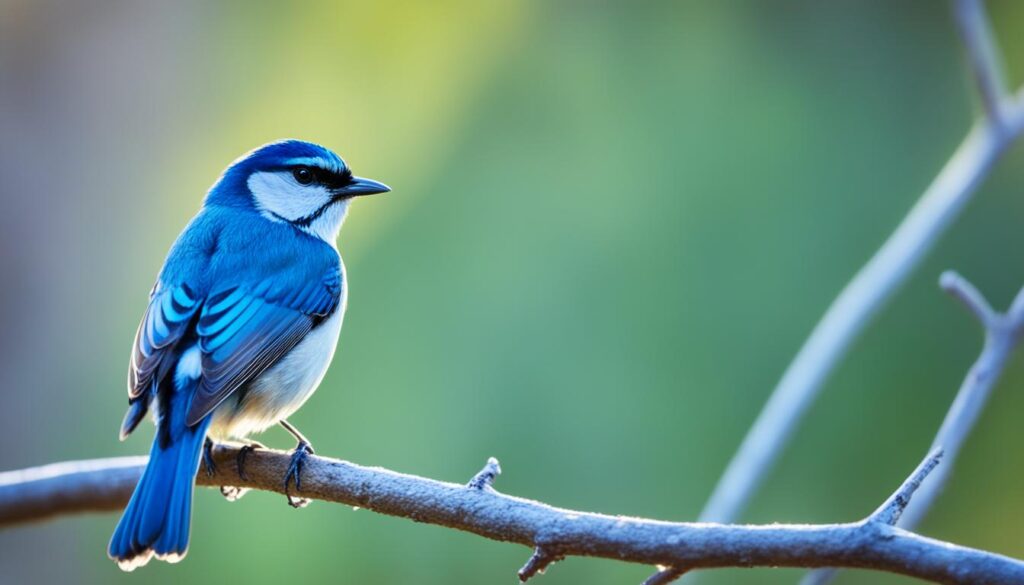
Despite their occasional aggression, nicators play a vital role in their ecosystem as pollinators and seed dispersers. Their feeding habits contribute to the health and diversity of African plant life, making them an essential part of the continent’s delicate balance of nature.
So, the next time you find yourself in the vast and diverse landscapes of Africa, take a moment to listen for the enchanting songs of the nicator. These melodious birds will surely leave an indelible mark on your heart and remind you of the incredible wonders that nature has to offer.
Noodlefish
The Noodlefish, also known as the Slender Fish, is a small species found in the North Pacific. These fish are known for their unique appearance and long, noodle-like bodies.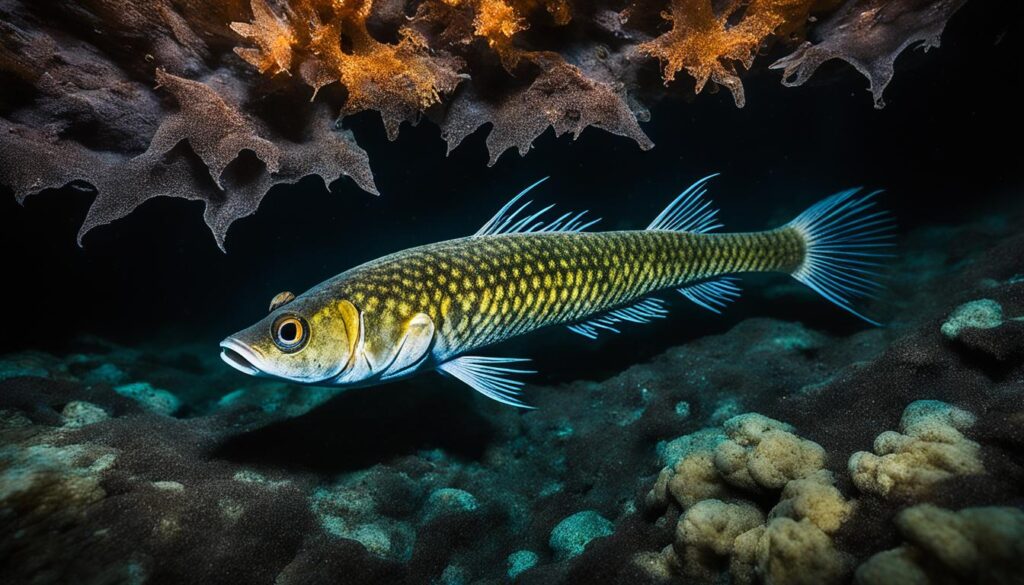
Despite their slender shape, Noodlefish are agile swimmers and are well adapted to their marine environment. They have streamlined bodies and powerful caudal fins that enable them to maneuver swiftly through the water.
Noodlefish primarily feed on small crustaceans, zooplankton, and other small marine organisms. Their elongated bodies and sharp teeth allow them to capture their prey with precision.
These fish are an important part of the North Pacific ecosystem, serving as a food source for larger predators and helping to maintain the balance of marine life.
Characteristics of the Noodlefish:
- Slender body shape
- Long, noodle-like appearance
- Powerful caudal fin for swimming
- Sharp teeth for capturing prey
It is fascinating to observe the Noodlefish in their natural habitat, gracefully gliding through the water with their unique body structure. Their distinct shape and behavior make them an intriguing species within the diverse marine ecosystem.
| Noodlefish Facts | |
|---|---|
| Habitat | North Pacific |
| Diet | Small crustaceans, zooplankton, marine organisms |
| Physical Characteristics | Slender body, long and noodle-like |
Nalolo
Nalolos are a type of wrasse fish mainly found in the Indian Ocean. They inhabit the vibrant coral reefs and tropical waters of this vast oceanic expanse. Nalolos are known for their vibrant colors and intricate patterns, making them a captivating sight for divers and snorkelers.
One fascinating aspect of nalolos is their ability to change their gender as they mature. They start their lives as females and then transition into males as they grow older. This unique reproductive strategy, known as sequential hermaphroditism, allows nalolos to optimize breeding opportunities within their social groups.
Their behavior and appearance also change as they undergo this gender transformation. Female nalolos typically have a vibrant orange or yellow coloration, while males exhibit more subdued hues of blue, green, and red. This color variation serves as a visual signal to potential mates and rivals within their ecosystem.
To showcase the beauty of nalolos, here is an image of these mesmerizing wrasse fish:

Nightcrawler
Nightcrawlers, also known as earthworms, are large and commonly used as bait for fishing. These slimy creatures are beneficial for anglers looking to attract a variety of fish species. With their wriggling movement and aroma, nightcrawlers entice fish to strike, making them a popular choice among fishermen and fisherwomen.
One of the fascinating facts about nightcrawlers is their voracious appetite. These earthworms have a remarkable ability to consume up to one-third of their body weight in a single day! This hearty appetite helps them break down organic matter in the soil, contributing to the natural cycle of decomposition and nutrient recycling.
When using nightcrawlers as bait, anglers typically thread them onto a fishing hook, allowing the worms to move naturally in the water, mimicking the behavior of potential prey for fish. Their soft and supple bodies make them an enticing target for various fish species, including bass, trout, and catfish.
Whether you’re an experienced angler or just starting out, nightcrawlers are an excellent choice as bait for fishing. Not only are they readily available, but their effectiveness in attracting fish makes them a trusted option for anglers worldwide.
Conclusion
Exploring animals that start with the letter N offers a fascinating glimpse into the diverse world of wildlife. From the unique adaptations of the naked mole rat to the melodic songs of the nightingale, each animal possesses its own remarkable traits and behaviors. By learning about these animals, we gain a deeper appreciation for the incredible diversity and beauty of the natural world.
From the small amphibious newt to the majestic antelope known as the nyala, the list of animals that start with N is diverse and captivating. These creatures span different habitats and ecosystems, showcasing the wonders of our natural world. Whether it’s the nimble climbing skills of the nuthatch or the termite-feeding habits of the numbat, each animal plays a unique role in their respective ecosystems, contributing to the delicate balance of nature.
By understanding and appreciating animals that start with N, we not only expand our knowledge but also foster a greater sense of empathy and responsibility towards protecting our diverse wildlife. From the common to the lesser-known, each animal has a story to tell and a role to play in the grand tapestry of life. Let us continue to explore and celebrate the wonders of the animal kingdom, embracing the endless fascination found within the animals that start with N.
FAQ
Are there any common animals that start with the letter N?
What is a newt?
What is a nuthatch?
Why are nightingales known for their songs?
What is a numbat?
What is a nyala?
What are nematodes?
What is a nase?
What is a napu?
What is a Norwegian rat?
What are nicators?
What are noodlefish?
What are nalolos?
What are nightcrawlers?
Why should we explore animals that start with N?
Dana is our Lead Content Writer, bringing a wealth of knowledge and expertise to our team. With a background deeply rooted in animal studies and a profound love for all creatures, Dana is dedicated to crafting engaging and informative content that resonates with our audience. With Dana at the helm, you can trust that our content is accurate and engaging, catering to the diverse interests of animal enthusiasts everywhere.
-

 Vetted2 months ago
Vetted2 months ago15 Best Cat Foods for Managing Hyperthyroidism – Vet Approved and Feline Friendly
-

 Vetted2 months ago
Vetted2 months ago15 Best Dog Foods for Kidney Disease – Expert Recommendations for Your Pet's Health
-

 Vetted2 months ago
Vetted2 months ago15 Best Wet Cat Foods for Older Cats to Keep Them Healthy and Happy
-

 Vetted2 months ago
Vetted2 months ago14 Best Homemade Dog Food Recipes Your Pup Will Love – Vet Approved & Nutritious
-

 Vetted2 months ago
Vetted2 months ago15 Best Fresh Dog Food Delivery Services for Your Pup's Health and Happiness
-

 Animal Facts2 months ago
Animal Facts2 months agoSpring Animals: A Guide to Seasonal Wildlife
-

 Cats2 months ago
Cats2 months agoCat Weight Chart by Age: Kitten to Senior in Lbs
-

 Cats2 weeks ago
Cats2 weeks agoTop 5 Cat Breeders in Arkansas: A Guide





















